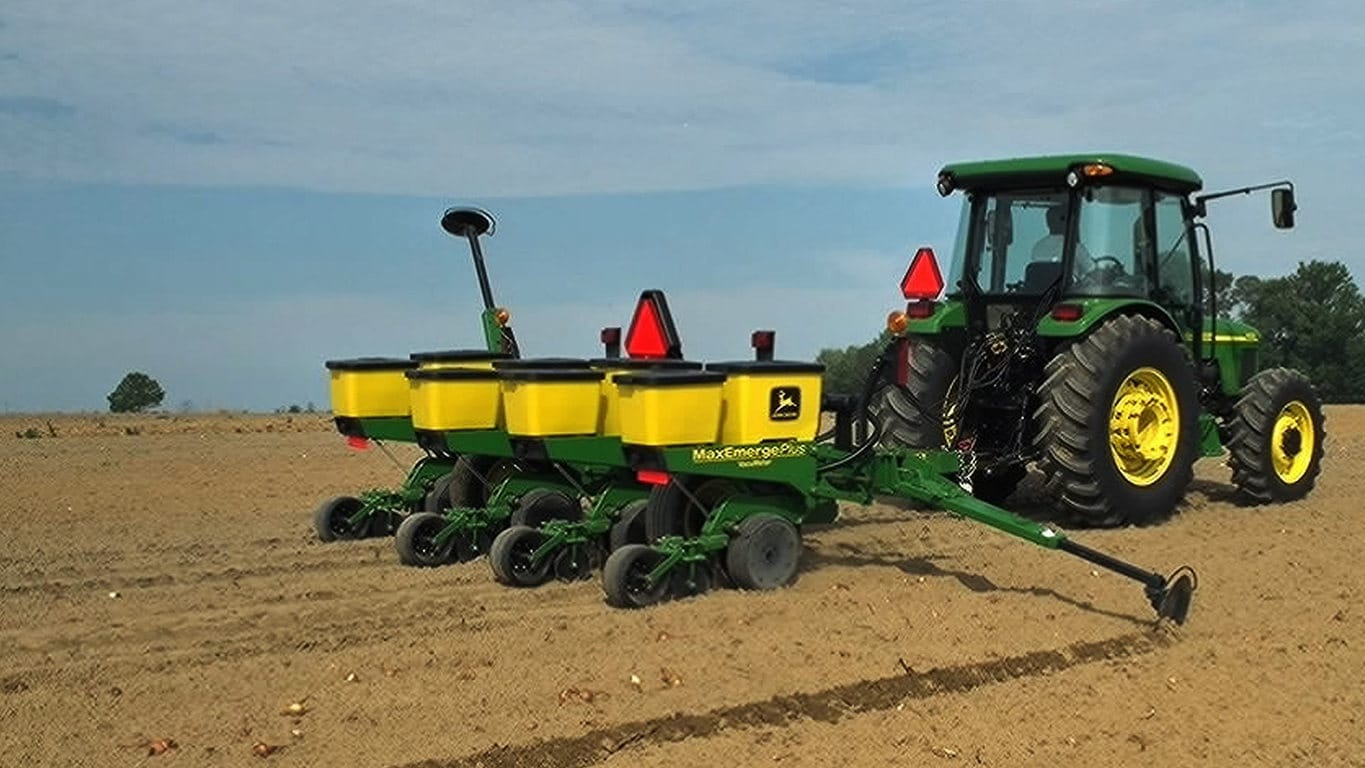
John Deere 1755
Drawn Planter
- Available in 1.6-bu. or 3-bu. MaxEmerge™ 5 row unit
- Insecticide option for 1.6-bu.
- 4-, 6-, and 8-row configurations
Features
MaxEmerge 5 bundles the best of MaxEmerge XP and Pro-Series™ XP row-units to give you a unique planter solution. With more options and configurations, you’ll get difference-making versatility that easily adapts to your ag management plan.
It starts with optimal seed population that drives yield potential. An improved double eliminated helps achieve your desired population with a ride range of crop sizes. Improved side-hill performance of up to ¼ degree ensures you receive the full value of each seed when planting on terraces or rolling terrain. The vacuum air source from the Central Commodity System (CCS™) tank in the meter provides a debris-free environment for increased meter efficiency.
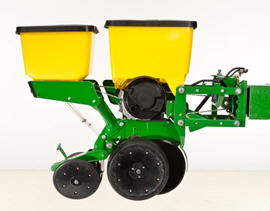 MaxEmerge 5 with 56-L (1.6-bu) hopper plus insecticide
MaxEmerge 5 with 56-L (1.6-bu) hopper plus insecticide
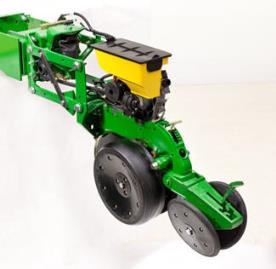 MaxEmerge 5 with mini-hopper on CCS™ machines only
MaxEmerge 5 with mini-hopper on CCS™ machines only
The MaxEmerge family of row-units have never seen a more versatile and efficient design until the MaxEmerge 5. The 5-family row-units improve productivity, increase uptime and lower the cost of ownership like never before.
The MaxEmerge 5 row-unit was designed for improved performance and serviceability.
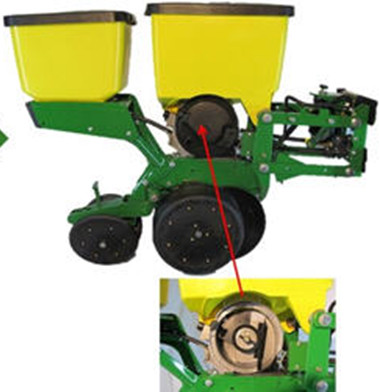 Easily access the meter
Easily access the meter
Serviceability and changing crops have always been a focus of downtime and potential seed loss. The MaxEmerge 5 meter (shown on the right) is accessible without having to remove the box. The design allows large hoppers to be cleaned out the same as mini-hoppers, simply by opening the meter dome and catching the seed as it falls out.
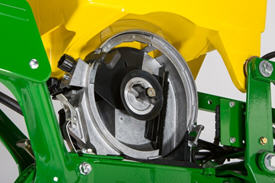 MaxEmerge 5 vacuum seed meter
MaxEmerge 5 vacuum seed meter
The vacuum meter system gently pulls and holds individual seeds to the holes of the seed disk for population control and spacing accuracy, equaling better crop stands and profit. Vacuum seed meters can plant a wide variety of crops and seed types by simply changing seed disks and adjusting vacuum level. Vacuum seed meters are available for planters with MaxEmerge 5 row-units.
Additional features of the vacuum seed meter include:
- One moving component (the seed metering disk) for minimum maintenance requirements
- Meter located at each row-unit for accurate seed delivery
- Good hopper seed flow characteristics for longer operating time per hopper fill
- Low airflow in meter so seed treatments are not removed
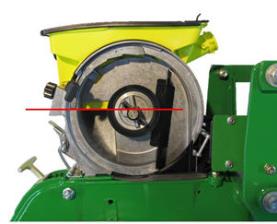 MaxEmerge 5 seed pool
MaxEmerge 5 seed pool
The MaxEmerge 5 meter shape has also been redesigned for better seed flow. The mini-hopper design allows the planter to successfully operate on side hills up to 14 degrees.
Vacuum meter hub and latching handle
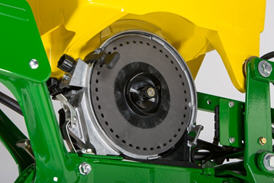 MaxEmerge 5 vacuum meter with disk
MaxEmerge 5 vacuum meter with disk
Both the MaxEmerge 5 vacuum meters are equipped with a heavy-duty hub spring and disk latching handle. The spring ensures the seed disk stays properly positioned when operating flat-style seed disks and higher vacuum levels. Proper seed disk positioning means repeatable seed singulation, time after time. The disk-latching handle is designed for easy operation and effortless seed disk changeover. The hub is also machined to tight tolerances to further ensure alignment of metering components.
Operating characteristics of vacuum seed meter
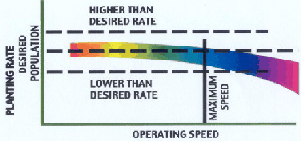 Operating speed with seed tube technology
Operating speed with seed tube technology
The vacuum seed meter can operate at faster planting speeds than mechanical meters. However, planting accuracy will be influenced by seedbed conditions and the operating characteristics of the seed meter. Rough seedbeds and fast planting speeds (above 8.9 km/h [5.5 mph]) typically deteriorate seed placement accuracies when using seed tube technology.
The chart illustrates the effect operating speed has on population when using the vacuum meter. The operating band (color area) illustrates how the vacuum meter performs in relation to the desired population (indicated by horizontal line). The width of the band is due to various sizes and shapes of seeds and planting rate variations.
When operating on slopes above 15 degrees, increased or decreased population may result. To minimize this effect, reduce speed and consider using a flat style seed disk with increased vacuum level.
Vacuum meter seed disks
The ProMax 40 Flat Disk is a flat-disk planting solution field-proven to work since 1991.
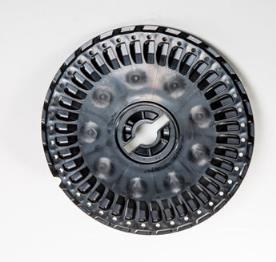 ProMax 40 Flat Disc
ProMax 40 Flat Disc
The design of the ProMax 40 Flat Disk position allows seed to be released from the optimum position above the seed tube. The flush-face seed tube allows the seed to drop uninterrupted through the tube.
The ProMax 40 Flat Disk utilizes flat holes and a higher vacuum level to ensure every hole is populated with a seed. A double eliminator gently removes multiple seeds at each hole for precise population control. A knockout wheel makes certain that each hole is clear of any debris after the seed is released from the disk.
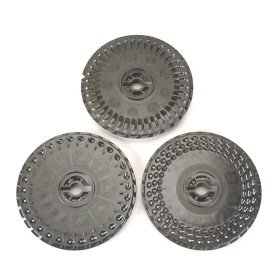 Flat-style and cell seed disks shown
Flat-style and cell seed disks shown
The unique cell disk design allows planting a variety of seed sizes without any additional parts or individual meter adjustments. Another advantage of cell-type seed disks is the lower vacuum requirement compared to flat-style seed disks. Lower vacuum levels mean less hydraulic demand from the tractor. Most planting conditions call for a flat disk, if you are limited in hydraulic capacity, cell disks are recommended.
Double eliminator
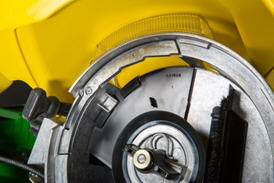 Flat seed disc and double eliminator
Flat seed disc and double eliminator
For difficult to singulate seeds, a flat seed disk and double eliminator is a viable alternative to traditional cell-type seed disks. By design, a flat seed disk requires higher levels of vacuum than a cell-type disk because there is no pocket or cell to hold the seed. The higher vacuum level will pull more than one seed to the holes in the seed disk. The double eliminator is set to cover a portion of the hole in the seed disk and is the mechanism to knock multiple seeds away as the disk rotates.
Double eliminators are required with flat-type seed disks only and should not be used with cell-type seed disks. The knockout wheel is also recommended in conjunction with the double eliminator and flat seed disk to ensure seed is ejected from the disk.
Flat and celled type seed metering disks are available to allow planting a wide variety of seed types.
- Corn (field, popcorn, or sweet corn)
- Soybeans
- Cotton
- Sorghum
- Sugar beets
- Sunflowers
- Edible beans/peas
- Peanuts
- Melons, squash, cucumbers
Mini-hopper row-units, which are used only with the CCS, are compatible only with crops that the CCS is approved to plant.
- Corn
- Popcorn
- Sweet corn
- Soybeans
- Sunflowers
- Sorghum
- Cotton
NOTE: Due to small seed size and low planting populations, sugar beets can be planted with mini-hopper style meters by adding hopper extensions and not using the CCS tank. These hopper extensions can also be used for planting test plots.
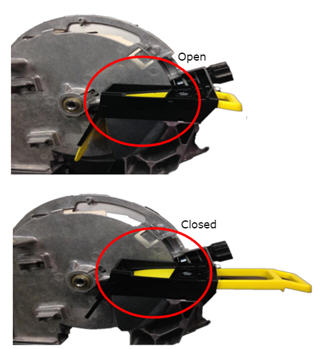 Hopper shutoff
Hopper shutoff

Also, to help with meter access of 56-L and 106-L (1.6-bu and 3-bu) hoppers the hopper shutoff feature was added. With the shutoff engaged, the meter cover can be opened without first having to remove all the seeds from the hopper. Lever down, the seed flow is on, lever horizontal and the seed flow is off.
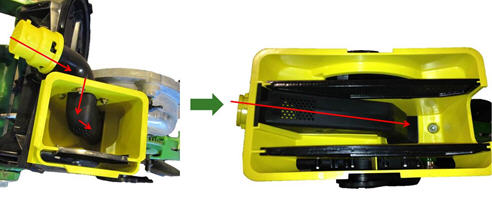 MaxEmerge 5 mini-hopper
MaxEmerge 5 mini-hopper

There are significant changes to the MaxEmerge 5 mini-hopper. One update is the straight feed from the CCS hose to the mini-hopper to ensure a continuous free flow of seeds. This design change reduces the potential for plugging issues with larger seed size and the use of seed treatments. By drawing air from the CCS tank, the vacuum source is cleaner, preventing meter debris buildup.
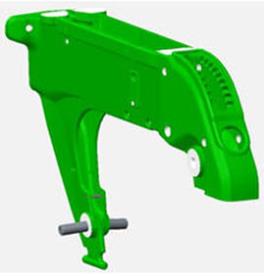 Ductile iron-cast shank
Ductile iron-cast shank
Ductile iron casting is a unique high-tech process that produces a single-piece row-unit shank this enables alignment from the seed trench to the closing wheel.
The row-unit head is also designed using the ductile iron-casting process. The row-unit head provides the mating joints between the row-unit parallel arms and the row-unit shank. It is also the upper attaching point for the seed meter and seed hopper.
Ductile iron casting of the row-unit shank and head assembly provides a row-unit that is 25 percent stronger than other competitive welded row-units.
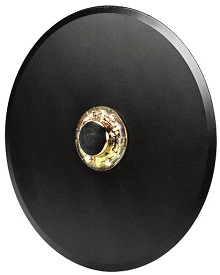 Tru-Vee opener blade
Tru-Vee opener blade
One of the trademark capabilities of John Deere planters has always been the ability of the Tru-Vee openers to provide an ideal seed furrow.
The thickness of the Tru-Vee opener blade is 3.5 mm (0.14 in.) this blade thickness will provide extended wear life.
The MaxEmerge 5 row-unit also provides better Tru-Vee opener bearings for longer life. The double-row ball bearing provides up to three times the wear life as the single-row bearing.
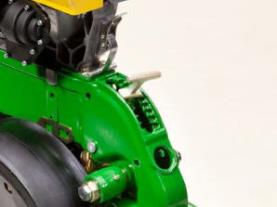 Depth adjustment T-handle
Depth adjustment T-handle

John Deere planters provide consistent seed depth control in all field conditions. Depth control is a function of the Tru-Vee openers, the downforce system, and the gauge wheel assembly.
The gauge wheel itself is made of durable nylon composition with a concave profile. This profile gently firms the sides of the seed furrow, ensuring a well-defined trench. The shape reduces rocks and residue being picked up and thrown onto the drive chains and row-units, and helps to prevent rooster tailing of soil.
The bolt-through design utilizes an open bearing in the gauge wheel that allows an attaching bolt to pass through the wheel to the threaded hole in the gauge wheel arm. This simple bolt-through design provides for a positive attachment of the gauge wheel to the gauge wheel arm and allows quick removal of the gauge wheel for service.
Adjustability of the row-unit is critical to good performance. More available downforce options than any row unit in the industry
- Adjustable heavy-duty downforce, four settings, 0 kg (0 lb), 57 kg (125 lb), 113 kg (250 lb), and 181 kg (400 lb) of downforce
- Pneumatic downforce, infinitely variable from 0 to 181 kg (0 to 400 lb) of downforce
- Active pneumatic downforce adjusts automatically for changing ground conditions from 0 to 181 kg (0 to 400 lb) of downforce
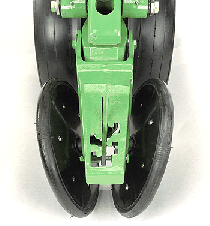 Rubber tire closing system
Rubber tire closing system
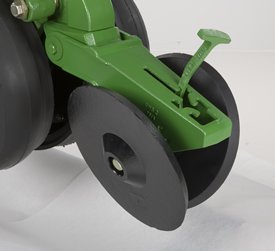 Cast wheel closing system
Cast wheel closing system
Rubber tire closing systems are used for most conventional, minimum-till, and no-till planting conditions. The spacing between the wheels is adjustable so the closing system can meet the needs of those who want to plant small seeds at shallow depths.
The wheels can also be staggered fore and aft to enhance residue flow. Four levels of spring force are available and are easily set with the integrated T-handle adjustment. A lower force spring can be obtained from parts, if a lower amount of force is required.
Additional closing wheel options include:
- Cast closing wheels for tough-to-close conditions
- Disk closing, for shallow planting depths
- Closing wheel frame less wheels for growers desiring to use aftermarket closing wheels
Individual Row Hydraulic Downforce (IRHD)
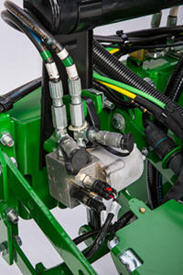 IRHD system
IRHD system
IRHD has been specifically designed to meet the needs of producers that are looking to adjust to the toughest field conditions and provide maximum yield potential from field to field, season after season. IRHD works as a closed-loop downforce system that reacts quickly on an individual row basis to changing soil conditions supporting increased ground contact, which can lead to improved seed depth consistency. When setting planter downforce margin, the system will apply the needed downforce by row to maintain ground contact. From the factory, the margin will be set at 45.4 kg (100 lb), changes may be required based on varying field conditions.
The system allows operators to maintain gauge wheel ground contact leading to desired seed depth placement. IRHD can adjust five times per second and make adjustments of 45.4 kg (100 lb) in less than a second. The system has a total range of applied downforce from 22.7 kg (50 lb) to 204.1 kg (450 lb) and utilizes the power beyond circuit on the tractor. IRHD is 58 percent faster than the active pneumatic downforce solution. Fast reaction and increased ground contact can lead to improved emergence. With uniform emergence, some studies have shown a yield impact from 5 percent to 9 percent.
IRHD is controlled through the display with SeedStar™ 3 HP or SeedStar 4HP. As shown below, operators can view ground contact or applied downforce using the toggle button.
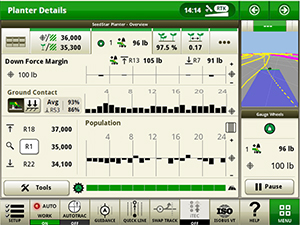 IRHD screen showing the ground contact graph through SeedStar 4HP
IRHD screen showing the ground contact graph through SeedStar 4HP
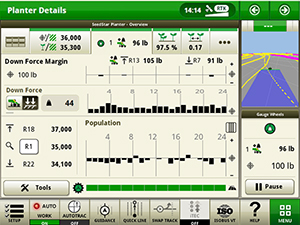 IRHD screen showing the applied downforce graph with SeedStar 4HP
IRHD screen showing the applied downforce graph with SeedStar 4HP
Hydraulically driven compressor
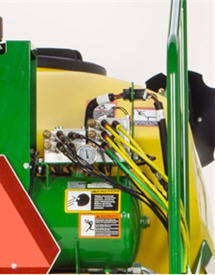 Pneumatic valve
Pneumatic valve
The hydraulically driven air compressor can deliver up to eight times the air flow when compared to the electric compressor, allowing for more and faster downforce changes to be made. This more robust design features a 37.8-L (10-gal.) storage tank across all models with active downforce.
At approximately 15.1 L/min (4 gpm), hydraulic demands are low and ties into the machine’s lift and Central Commodity System (CCS™) hydraulic circuit so it does not require any additional selective control valves (SCVs). The SeedStar XP, SeedStar 3 HP, and SeedStar 4 HP monitoring systems work with the compressor. SeedStar 3 HP and SeedStar 4 HP monitoring systems work with the compressor and valve assembly to regulate air to downforce springs, enabling the active control, pneumatic closing wheels, and pneumatic row cleaners.
Row-unit downforce planter run page
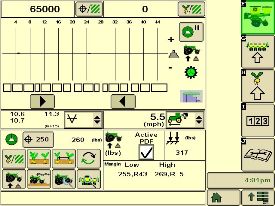 SeedStar XP downforce planter run page
SeedStar XP downforce planter run page
Active downforce control is integrated into SeedStar XP, SeedStar 3 HP, and SeedStar 4 HP monitoring systems.
Margin is the amount of weight riding on the depth gauge wheels that ensures desired firming of the seedbed as set by the operator.
Once a target margin has been defined, enter the value into the display and let active downforce do the rest. The system will actively adjust the air pressure in the air bags to maintain a constant margin across the planter. The changes in air pressure will change the amount of downforce placed on the row-unit, compensating and reacting for varying conditions through the field whether it is different tillage practices, soil types, or moisture.
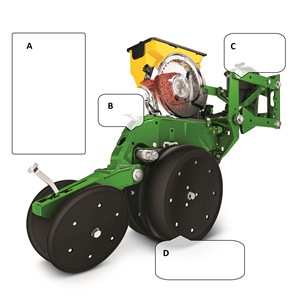 Downforce and margin example
Downforce and margin example
- A - Margin – amount of additional downforce applied to a row-unit above and beyond what is required for penetration to achieve planting depth. This additional weight will ride on the depth gauge wheels.
- 54.4 kg (120 lb) + 36.3 kg (80 lb) = 90.7 kg (200 lb) – 68 kg (150 lb) = 22.7 kg (50 lb) of margin
- B - Weight of row-unit - 54.4 kg (120 lb)
- C - Downforce – force that is applied to the row-unit by the air bag circuit - 36.3 kg (80 lb)
- D - Resistance from soil - 68 kg (150 lb)
Margin video references:
Using Active Pneumatic downforce
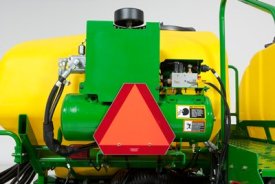 Active downforce compressor assembly
Active downforce compressor assembly
A hydraulically driven compressor works with the SeedStar XP, SeedStar 3 HP, and SeedStar 4 systems to automate downforce control. Just set the row-unit target margin value and the active pneumatic downforce system works automatically. The system will make sure the planter maintains this value, achieving precise soil penetration, and consistent planting depth, without sidewall soil compaction. From the factory, the system is set at 45.4 kg (100 lb) target downforce margin but may be modified for varying field conditions. This frees the operator from constantly making manual downforce adjustments as conditions change.
This system offers a split-rank control feature for 1795 and DB Split-Row Planters. On split-row planters, active downforce will control the front and rear rows independently. This compensates for differing downforce requirements between the ranks that can be caused by things like different tillage or insecticide attachments and will help maintain an accurate planting depth and consistent margin across all the rows.
Active pneumatic downforce is available as factory installed or as an attachment for field conversion.
Set point row-unit downforce
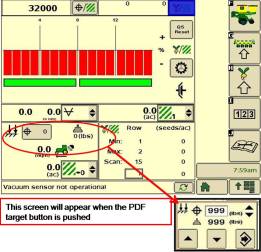 Pneumatic downforce control in GreenStar 2 Display
Pneumatic downforce control in GreenStar 2 Display
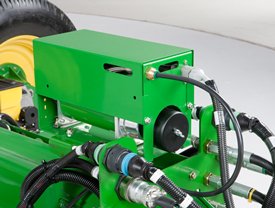 Air compressor mounted on 1775NT outer hitch
Air compressor mounted on 1775NT outer hitch
On set point, the air compressor will be mounted on the outer hitch or frame assembly. Since the electric air compressor assembly is mounted on the outer hitch (as noted in the picture above) or frame, adjustments for row-unit downforce and related system pressures will be made electronically with the GreenStar display.
When adjusting the amount of row-unit downforce using the GreenStar display, the operator will select the amount of downforce (kg [lb]) to be applied across the planter. Depending on the soil conditions at hand, the operator might need to adjust the relative amount of row-unit downforce being applied during the planting operation. The integrated pneumatic downforce controls within the GreenStar display will only allow for set-point operation and not automatic control as the planter is operating in different soil conditions. The pneumatic downforce system does not have the capability to automatically adjust downforce.
Pneumatic downforce provides convenient, simple adjustment of downforce for the whole planter from one location. The amount of downforce applied is infinitely adjustable from 6.8 to 181.4 kg (15 to 400 lb). Pneumatic downforce provides more consistent downforce throughout the range of row-unit travel than mechanical spring downforce systems.
Features include:
- 9.5-mm (3/8-in.) air delivery line instead of the 6.4-mm (1/4-in.) line used on model year 2010 and older planters.
- Air compressor assembly increased duty cycle. With this compressor, it provides a 47 percent increase in maximum air flow delivery compared to the prior air compressor.
- Pneumatic air bags with 9.5-mm (3/8-in.) air line inlets that have greater durability.
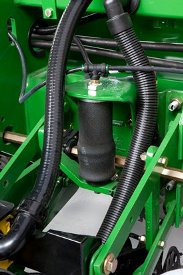 Pneumatic downforce spring
Pneumatic downforce spring
Each row-unit has a single rubber air bag located between the parallel arms. The air bags are hooked in parallel so that air can be added or released from all rows at once from one location.
The individual pneumatic downforce air bag assemblies, air compressor units, and 9.5-mm (3/8-in.) delivery lines are also available as an attachment for field conversion.
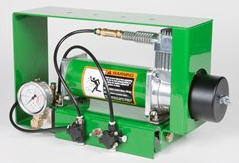 Pneumatic downforce compressor and gauge
Pneumatic downforce compressor and gauge
An improved compressor is used to charge the pneumatic system. This compressor can be located on the planter frame or in the tractor cab if desired. A gauge at the compressor indicates the amount of downforce being applied.
Integrated pneumatic downforce system
The functional features of the integrated system are the same as the standard pneumatic system, explained above, with the addition of control through the GreenStar display.
Heavy-duty adjustable downforce springs
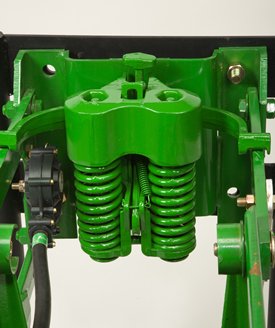 Heavy-duty adjustable downforce spring
Heavy-duty adjustable downforce spring
Planter row-unit downforce is an important factor to ensure consistent and proper depth control. The heavy-duty adjustable downforce feature provides up to 181.4 kg (400 lb) of downforce. There are four settings available to allow the operator to choose the amount of downforce required for the condition: 0 kg (0 lb), 56.7 kg (125 lb), 113.4 kg (250 lb), and 181.4 kg (400 lb).
Crop yields have increased through the years along with the amount of residue left in the field after harvest. At the same time, tillage practices have changed, including different tillage operations which maintain large amounts of surface residue, and even no-till practices. Row cleaners are an essential tool in managing this increased amount of residue.
John Deere seeding group offers a variety of row cleaner options to meet the needs of a producer's operation. Compatibility varies by model, row spacing, and other planter equipment.
Screw-adjust, unit-mounted row cleaner
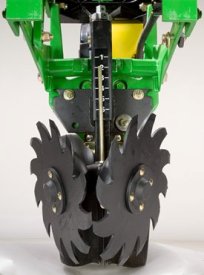 Screw-adjust, unit-mounted row cleaner
Screw-adjust, unit-mounted row cleaner
The screw-adjust, unit-mounted row cleaner is mounted directly to the face plate of the row-unit, placing the ground engaging components just in front of the row-unit opener blades and depth gauge wheels. This close proximity allows the gauge wheels to control the depth of the row cleaner as well as the row-unit. This compact design also allows greater compatibility with fertilizer openers and other planter attachments.
SharkTooth® wheels are standard equipment on the unit-mounted row cleaner. The swept-tooth design of the wheel provides a clear path for the row-unit openers while resisting residue buildup on the wheel. The screw adjustment knob is accessible through the top of the parallel arms, providing convenient access for adjustments. The row cleaner can be adjusted in 1.6-mm (1/16-in.) increments, providing plenty of flexibility to meet the needs of changing conditions.
Floating row cleaner with unit-mounted coulter
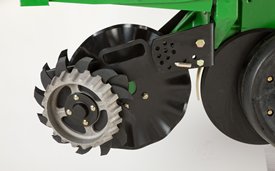 Floating row cleaner with unit-mounted coulter
Floating row cleaner with unit-mounted coulter
The floating row cleaner allows a row cleaner to be used in conjunction with a unit-mounted coulter. This combination is often desired in heavy residue loads and reduced tillage planting conditions. The row cleaner provides a clear path for the row-unit, while the unit-mounted coulter helps penetrate tough soil conditions.
Accommodating the unit-mounted coulter means the residue wheels are farther forward from the row-unit face plate than in the case of the screw-adjust row cleaner. To maintain performance, this row cleaner has the capability to float above a defined minimum depth.
Standard depth-gauging bands on the wheels allow the row cleaner wheels to float independently of the row-unit openers, allowing both to perform in varying terrain. The unit may also be set in a fixed position by simply pinning through the bracket if desired. This row cleaner also features SharkTooth wheels as standard equipment.
The floating row cleaner and unit-mounted coulters are available on many planters as factory-installed equipment.
NOTE: Screw-adjust row cleaners are not compatible with MaxEmerge™ 5e row-units with long parallel arms.
NOTE: DB models have the option for either unit-mounted coulter, screw-adjust row cleaners, or pneumatic row cleaners (only compatible with MaxEmerge 5e or equipped ExactEmerge™ models). The DB60T is only available with a less row cleaner option.
SharkTooth is a trademark of Yetter Manufacturing, Inc.
Seed variable-rate drive provides the ultimate planting productivity by utilizing one, two, or three hydraulic motors (varies by model) to turn the seeding drive shaft. Hydraulic control of the seeding drive allows for on-the-go seeding rate changes right from the display mounted inside the tractor cab. Combine this seeding flexibility with the map-based planting option, and seeding rates adjust automatically based on the prescribed map.
Variable-rate drive offers the following advantages over common, ground, or contact-tire drive systems:
-
Rate changes are almost instantaneous; no ramp up or ramp down of system as in some competitive systems
- Permits the producer to match seed population based on different soil types or irrigation practices
- John Deere design provides added operator safety by eliminating any possible drive creep found in some competitive variable-rate drive systems
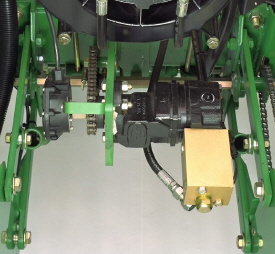 1755 equipped with variable-rate drive
1755 equipped with variable-rate drive
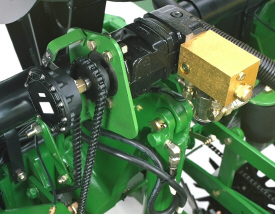 1765NT equipped with variable-rate drive
1765NT equipped with variable-rate drive
Single- or dual-motor systems for variable-rate drives are available for all John Deere planters except the 1785 Rigid Frame. Variable-rate drive is available as a factory-installed option for all applicable planter models.
Single- or dual-motor systems are available as field-installed attachments for most planter models; however, a three-motor variable-rate drive field-installed attachment is not available.
Seed variable-rate drive requires the SeedStar™ monitor and a radar input signal. Either tractor or planter radar may be used. Planter radar is ordered separately.
NOTE: Peanut seed meter disks require the variable-drive transmission.
Granular fertilizer hopper and transmission
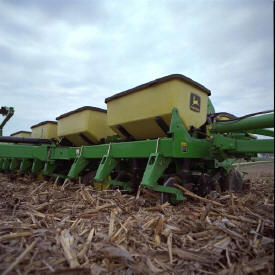 Granular fertilizer hopper and opener
Granular fertilizer hopper and opener
Granular fertilizer is available for 1755, 1775, and 1785 Planters. Fertilizer hoppers/tanks and selected other equipment may not be installed to facilitate shipping. Fertilizer attachments place fertilizer only on 76.2-cm, 91.4-cm, or 96.5-cm (30-in., 36-in., or 38-in.) spacings. Some planter frame and row spacing combinations result in the opener offset 10.1 cm to 15.2 cm (4 in. to 6 in.) from the centerline of the Tru-Vee opener.
Hoppers hold approximately 249.5 kg (550 lb) of fertilizer for longer operating time between fill-ups. One hopper feeds two rows. Hopper lids provide a large opening for fast filling with less spillage. Hoppers pivot for easy dumping and cleaning.
The transmission (two on 1775) has 24 sprocket combinations in consistent 6 percent increments to allow operators to apply fertilizer at the desired application rate. Depending on which auger is selected, a wide range of fertilizer rates can applied from 52.7 kg/ha (47 lb/acre) to 803.7 kg/ha (717 lb/acre). It requires openers or a surface application bracket.
Augers for granular fertilizer system
Low-, regular-, or high-rate feed augers are required to complete the granular fertilizer system. Augers move fertilizer from the fertilizer boxes to the opener. Regular- or high-rate augers are matched with the opener style selected and are available as a factory-installed option or as an attachment for field conversion. Low-rate augers are only available as an attachment for field conversion.
For 76.2-cm (30-in.) rows, the approximate rate of application is as follows:
-
Low-rate augers – 52.7-139 kg/ha (47-124 lb/acre)
-
Regular-rate augers – 105.4-533.5 kg/ha (94-476 lb/acre)
-
High-rate augers – 183.8-803.7 kg/ha (164-717 lb/acre)
For 96.5-cm (38-in.) rows, the approximate rate of application is as follows:
-
Low-rate augers – 41.5-208.5 kg/ha (37-186 lb/acre)
-
Regular-rate augers – 82.9-418.1 kg/ha (74-373 lb/acre)
-
High-rate augers – 124.4-626.6 kg/ha (111-559 lb/acre)
NOTE: Weight metered may vary from that indicated because the fertilizer attachment will meter by volume not by weight and because of differences in fertilizer density.
1755 and 1785 granular fertilizer openers
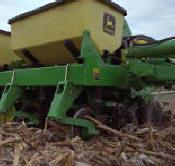 Granular fertilizer opener
Granular fertilizer opener
Frame-mounted, double-disk openers and frame-mounted, single-disk openers for granular fertilizer are available on the 1755 and 1785 Planters. The frame-mounted, single-disk opener is available with a regular spout or cast spout. Fertilizer openers place the granular fertilizer into the soil for maximum plant uptake and are adjustable. Single-disk fertilizer openers are required for no-till, but are also suitable for conventional and reduced tillage. Double-disk fertilizer openers should only be used in conventional and reduced tillage conditions.
-
Single- and double-disk openers are compatible with frame-mounted coulters.
-
Single-disk opener with cast spout is recommended for all soil conditions because it keeps soil from flowing into the furrow before fertilizer is delivered.
-
The gauge wheel on single-disk openers will help gauge fertilizer application depth and minimize soil disruption.
-
On 1755 8Row30 Planters, due to frame limitations, the granular fertilizer systems with single-disk openers can place fertilizer no closer than 12.7 cm to 15.2 cm (5 in. to 6 in.) to the seed furrow on rows 4 and 5.
1770 granular fertilizer openers
Frame-mounted, single-disk fertilizer openers with cast spout are utilized on the 1775 12Row30 Planter. These openers are ideal for both conventional and no-till. The openers are adjustable to place the fertilizer in the soil next to the seed furrow for ideal nutrient placement and maximum plant uptake. A single gauge wheel allows the opener to follow the contour of the ground for ideal fertilizer depth placement. Single-disk fertilizer openers are compatible with frame-mounted coulters.
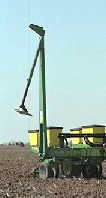 Folding marker
Folding marker
A 406.4-mm (16-in.) notched marker disk blade with a 101.6-mm (4-in.) wide depth gauging band is base equipment on folding markers. Notched marker disk blades are compatible with all tillage conditions but are recommended for no-till and high-residue mulch-till conditions. This marker uses a 44.45-mm (1.75-in.) square tube marker arm extension.
Folding markers are base equipment on the following planter model configurations:
- 1755 8Row30
- 1785 8Row30 and 15Row15
Although not in base equipment, folding markers are available for the following integral planter configurations:
-
1705 6Row30, 6Row38, 6Row40, 8Row30, 8Row38, 8Row40, and all 10Row
-
1715 all rows
-
1735 all rows
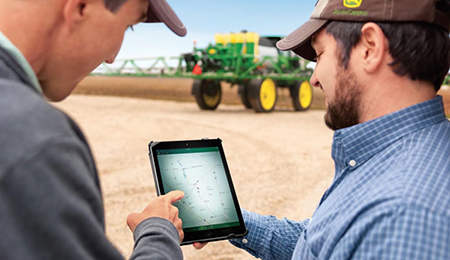 Connected Support technology
Connected Support technology
When you buy John Deere equipment, you expect reliability. You also know that problems can happen, and a product is only as good as the support behind it. That’s why John Deere equipment is prepared with technology that senses potential issues and can alert you and your dealer promptly—in the cab or anywhere you are.
John Deere Connected Support is a revolutionary change to support that leverages technology and the connectivity of JDLink™ telematics to prevent downtime and resolve problems faster. These tools decrease downtime by an average of 20 percent, enabling faster responses to unexpected problems and reducing technician trips to your machine. For some issues, unplanned downtime can even be prevented altogether through prediction of the issue.
With your permission, John Deere Connected Support:
- Keeps you running by monitoring machine health and promptly alerting you and your dealer of issues
- Saves time by remotely viewing in-cab displays, reducing trips to the machine
- Reduces or even eliminates technician trips to a machine through remote diagnostic and remote software reprogramming capabilities
- Connects experts with the information needed to respond to downtime faster and prevent it altogether
With more than a decade of experience leveraging connectivity to solve problems, no one else has the experience, tools, and knowledge to keep you running as John Deere and your John Deere dealer can. Connected Support is an in-base feature on all John Deere products with factory- or field-installed JDLink.
Specs & Compare
Key Specs | 1755 Current Model |
| Number of rows | 4, 6, or 8 |
| Row spacing | 4-Row: 76, 91, or 97 cm 30, 36, or 38 in. 6-Row Narrow: 70 or 76 cm 27.5 or 30 in. 8-Row Narrow: 76 cm 30 in. |
| Frame - Fold configuration | |
| Frame - Flexibility | |
| Row unit seed hoppers | Capacity 58 or 106 L 1.6 or 3 bu |
| Seed Meters | Optional Finger pickup, vacuum or radial bean meter |
Rows and Row Spacing | |
| Number of rows | 4, 6, or 8 |
| Row spacing | 4-Row: 76, 91, or 97 cm 30, 36, or 38 in. 6-Row Narrow: 70, or 76 cm 27.5, or 30 in. 8-Row Narrow: 76 cm 30 in. |
Frame | |
| Fold configuration | |
| Frame tube size | |
| Fold-and-go from tractor cab | |
| Flexibility | |
Hitch | |
| Base | |
| Optional | |
| Rear hitch | |
Lift System | |
| Type | Wheel hydraulic cylinders |
| Number of cylinders | |
Tires | |
| Base | 7.60-15 8PR rib implement |
| Optional | |
| Quantity | |
Row Units | |
| Type | MaxEmerge™ 5 row units |
| Opener | Tru-Vee Double Disk |
| Depth gauging | |
| Adjustment | |
| Walking wheels | |
| Row unit seed hoppers | Capacity 58 or 106 L 1.6 or 3 bu |
| Row unit down force | |
| Scrapers, opener blades | |
| Seed tube sensors | |
Seed Meters | |
| Base | |
| Optional | Finger pickup, vacuum or radial bean meter |
| Finger pickup | |
| Radial bean meter | |
| Central Commodity System | |
Drive System | |
| Base | Sprocket and chain from drive wheels |
| Optional | |
| Number of drive wheels | |
| Drive wheel disconnect | |
| Counter shaft | |
| Drill shaft | |
| Seed transmission | |
| Transmission combinations | |
Markers | |
| Type | Automatic alternating or independent control |
| Control | |
| Marker disk | |
| Shear bolt protection | |
| Less marker option | |
Closing System | |
| Rubber tire closing system | |
| Cast iron closing system | |
Herbicide and Insecticide | |
| Insecticide only hopper | |
| Herbicide only hopper | |
| Insecticide and herbicide hopper | |
Liquid Insecticide System | |
| System available | |
| Tank capacity | |
Seed Monitor System | |
| Base | |
| Optional | |
Tillage Attachments | |
| Unit-mounted coulter | |
| Frame-mounted coulter | |
| Bubble blade | |
| .63-in. fluted blade (25 flutes) | |
| .7-in. fluted blade (13 flutes) | |
| 1-in. fluted blade (8 flutes) | |
| Row tillage support hanger | |
| Tine tooth | |
| Cons. furrower w/ leading cutout blade | |
| V-wing bed sweeps | |
| Row cleaner | |
| Row cleaner - unit-mounted coulter | |
| Row cleaner - unit-mounted DD fert. opener | |
Fertilizer | |
| Onboard / towed / tractor tanks | |
| Tank capacity | |
| Fixed-rate application | |
| Variable-rate application | |
| Pump type | |
| Pump rate | |
| Fertilizer opener type | |
| Flow divider distribution system | |
| Pressure manifold distribution system | |
| Dry fertilizer | |
Dimensions | |
| Transport width (with markers) | |
| Transport width (without markers) | |
| Transport length | 4-Row: 3970 mm 13.5 ft 6-Row: 3970 mm 8-Row Narrow: 4625 mm 15.16 ft |
| Transport height | 4-Row Narrow: 2743 mm 9 ft 4-Row Wide: 2845 mm 9.33 ft 6-Row Narrow: 3505 mm 11.5 ft 8-Row Narrow: without fertilizer: 1435 mm (56.5 in.) With dry fertilizer: 1700 mm (67 in.) With liquid fertilizer: 1830 mm (72 in.) |
| Transport weight | Average frame weight: 4-Row: 1350 kg 2975 lb 6-Row: 1825 kg 4025 lb 8-Row: 2675 kg 5900 lb |
| Transport underframe clearance | |
| Field operation width | 4-Row Narrow: 3962 mm 13 ft 4-Row Wide: 3962 mm 6-Row Narrow: 4775 mm 15.66 ft 8-Row Narrow: 5875 mm 19.275 ft With markers in transport: 6320 mm 248.75 in. |
| Field operation length | |
Ag Management Solutions | |
| Map-based seeding | |
| Field documentation | |
| Parallel tracking | |
Additional Information | |
| Recommended tractor horsepower | 4-Row: 45 kW 60 PTO hp 6-Row Narrow: 60 kW 80 PTO hp 8-Row Narrow: 90 kW 120 PTO hp |
| Recommended tractor hydraulics | Hydraulic oil required to operate machine: 4R and 6RN approximately: 2.8 L 0.75 gal. 8RN approximately: 5.7 L 1.5 gal. Tractor standby hydraulic pressure: 15,515 kPa 155 bar (2250 psi) Hydraulic system working pressure: 20,684 kPa 207 bar (3000 psi) Hydraulic system burst pressure: 82,737 kPa 827 bar (12,000 psi) |
| Warranty length | |
| Date collected |
Offers & Discounts
Accessories & Attachments
Down Force
Upforce / Downforce spring systems
Planter row-unit downforce is an important factor to ensure consistent and proper depth control. Downforce systems are used to keep the planting units from bouncing on rough seedbeds and to improve planter penetration in heavy residue and harder soil conditions. The amount of downforce required is determined by how the planter is equipped and the field conditions in which the planter is used.
Non-adjustable springs can also be used to apply upforce on the row-units. Upforce can be achieved by changing the orientation of the spring on the parallel arms. This upforce can be used to counteract excess
row-unit margin or extra weight cause by seed, tillage, or other attachments on the row-unit. Upforce springs will limit the maximum amount of downforce that can be place on a row-unit by the downforce system and should only be used in conditions were adequate and consistent depth control is easily maintained.
Non-adjustable springs in the upforce or downforce position can also be used to counteract variances in row to row. When used in conjunction with the pneumatic downforce system, non-adjustable springs can be used to provide a more consistent row-unit margin on each row by compensating for inconsistencies such as tire tracks, different row-unit tillage attachments, and other various attachments.
Non-adjustable springs
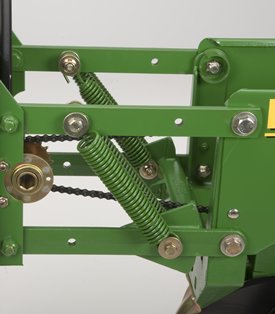 Non-adjustable springs, row-unit upforce
Non-adjustable springs, row-unit upforce
A single set of springs apply approximately 90 lb of upforce / downforce per row. Two sets of springs can be used for 180 lb of force per row.
Non-adjustable downforce springs are recommended for use in conventional tilled soil for planting speeds over 5 mph and/or in rough-tilled seedbed conditions. Non-adjustable springs can be used with tillage attachments in lighter, conventional tilled soils. (Not recommended for use with unit- or frame-mounted coulter.)
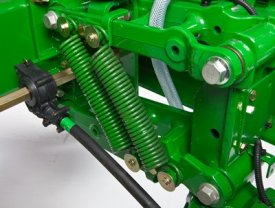 Dual upforce springs 1700 TR
Dual upforce springs 1700 TR
Adjustable heavy-duty springs
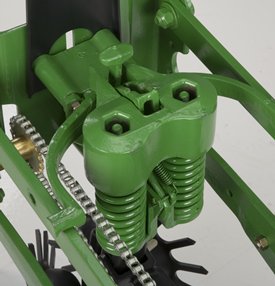 Adjustable, heavy-duty downforce springs
Adjustable, heavy-duty downforce springs
Adjustable, heavy-duty downforce can be used to apply 0 lb to 400 lb of downforce per row and has four settings: 0 lb, 125 lb, 250 lb, and 400 lb. The adjustable, heavy-duty downforce system can be used in all planting conditions and is compatible with all tillage attachments (recommended with unit-mounted coulter, row cleaners, and unit-mounted double-disk fertilizer openers in conservation planting conditions).
- NOTE: Compatible with all MaxEmerge™ Plus planters. Vacuum planters built prior to June 1992 require updated manifold brackets (A52970) to eliminate adjustment interference.
Upforce / Downforce spring systems
Planter row-unit downforce is an important factor to ensure consistent and proper depth control. Downforce systems are used to keep the planting units from bouncing on rough seedbeds and to improve planter penetration in heavy residue and harder soil conditions. The amount of downforce required is determined by how the planter is equipped and the field conditions in which the planter is used.
Non-adjustable springs can also be used to apply upforce on the row-units. Upforce can be achieved by changing the orientation of the spring on the parallel arms. This upforce can be used to counteract excess
row-unit margin or extra weight cause by seed, tillage, or other attachments on the row-unit. Upforce springs will limit the maximum amount of downforce that can be place on a row-unit by the downforce system and should only be used in conditions were adequate and consistent depth control is easily maintained.
Non-adjustable springs in the upforce or downforce position can also be used to counteract variances in row to row. When used in conjunction with the pneumatic downforce system, non-adjustable springs can be used to provide a more consistent row-unit margin on each row by compensating for inconsistencies such as tire tracks, different row-unit tillage attachments, and other various attachments.
Non-adjustable springs
 Non-adjustable springs, row-unit upforce
Non-adjustable springs, row-unit upforce
A single set of springs apply approximately 90 lb of upforce / downforce per row. Two sets of springs can be used for 180 lb of force per row.
Non-adjustable downforce springs are recommended for use in conventional tilled soil for planting speeds over 5 mph and/or in rough-tilled seedbed conditions. Non-adjustable springs can be used with tillage attachments in lighter, conventional tilled soils. (Not recommended for use with unit- or frame-mounted coulter.)
 Dual upforce springs 1700 TR
Dual upforce springs 1700 TR
Adjustable heavy-duty springs
 Adjustable, heavy-duty downforce springs
Adjustable, heavy-duty downforce springs
Adjustable, heavy-duty downforce can be used to apply 0 lb to 400 lb of downforce per row and has four settings: 0 lb, 125 lb, 250 lb, and 400 lb. The adjustable, heavy-duty downforce system can be used in all planting conditions and is compatible with all tillage attachments (recommended with unit-mounted coulter, row cleaners, and unit-mounted double-disk fertilizer openers in conservation planting conditions).
- NOTE: Compatible with all MaxEmerge™ Plus planters. Vacuum planters built prior to June 1992 require updated manifold brackets (A52970) to eliminate adjustment interference.
Upforce / Downforce spring systems
Planter row-unit downforce is an important factor to ensure consistent and proper depth control. Downforce systems are used to keep the planting units from bouncing on rough seedbeds and to improve planter penetration in heavy residue and harder soil conditions. The amount of downforce required is determined by how the planter is equipped and the field conditions in which the planter is used.
Non-adjustable springs can also be used to apply upforce on the row-units. Upforce can be achieved by changing the orientation of the spring on the parallel arms. This upforce can be used to counteract excess
row-unit margin or extra weight cause by seed, tillage, or other attachments on the row-unit. Upforce springs will limit the maximum amount of downforce that can be place on a row-unit by the downforce system and should only be used in conditions were adequate and consistent depth control is easily maintained.
Non-adjustable springs in the upforce or downforce position can also be used to counteract variances in row to row. When used in conjunction with the pneumatic downforce system, non-adjustable springs can be used to provide a more consistent row-unit margin on each row by compensating for inconsistencies such as tire tracks, different row-unit tillage attachments, and other various attachments.
Non-adjustable springs
 Non-adjustable springs, row-unit upforce
Non-adjustable springs, row-unit upforce
A single set of springs apply approximately 90 lb of upforce / downforce per row. Two sets of springs can be used for 180 lb of force per row.
Non-adjustable downforce springs are recommended for use in conventional tilled soil for planting speeds over 5 mph and/or in rough-tilled seedbed conditions. Non-adjustable springs can be used with tillage attachments in lighter, conventional tilled soils. (Not recommended for use with unit- or frame-mounted coulter.)
 Dual upforce springs 1700 TR
Dual upforce springs 1700 TR
Adjustable heavy-duty springs
 Adjustable, heavy-duty downforce springs
Adjustable, heavy-duty downforce springs
Adjustable, heavy-duty downforce can be used to apply 0 lb to 400 lb of downforce per row and has four settings: 0 lb, 125 lb, 250 lb, and 400 lb. The adjustable, heavy-duty downforce system can be used in all planting conditions and is compatible with all tillage attachments (recommended with unit-mounted coulter, row cleaners, and unit-mounted double-disk fertilizer openers in conservation planting conditions).
- NOTE: Compatible with all MaxEmerge™ Plus planters. Vacuum planters built prior to June 1992 require updated manifold brackets (A52970) to eliminate adjustment interference.
Fertilizer
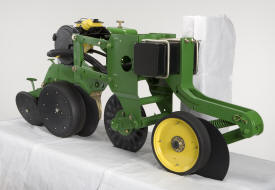 7-in. x 7-in. single-disk opener installed
7-in. x 7-in. single-disk opener installed
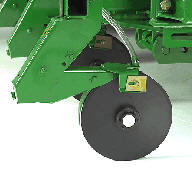 Double-disk opener assembly
Double-disk opener assembly
Frame-mounted fertilizer openers are recommended for the following tillage conditions:
Openers |
Conventional |
Reduced |
Moderate, no-till |
Moderate, double crop |
Single disk |
X |
X |
X |
X |
Double disk |
X |
X |
|
|
Depending on the model, single-disk or double-disk frame-mounted fertilizer openers options are available to meet a wide range of operating conditions. The single-disk frame-mounted fertilizer opener is the most robust and versatile of the two frame-mounted options.
There are two designs of frame-mounted single disk fertilizer openers available for planters today:
- One design mounts to rigid frame or folding planters and utilizes a steel upper arm for secure mounting. This style opener is shown in the right-hand picture above and has been available for a number of years.
- The second design of frame-mounted single-disk openers is strictly for 7-in. x 7-in. frames and is for use on the 1770NT, 1770NT CCSTM, and 1790 Planters (excluding the 24Row20). This design incorporates a longer curved upper casting and is shown in the left-hand picture above.
Single-disk fertilizer openers feature a gauge wheel to:
-
Gauge fertilizer application depth
-
Minimize soil disruption
The frame-mounted, single-disk opener has the ability to be locked up in the raised position on 1790 Split-Row Planters. This eliminates excessive wear to the openers when planting soybeans with a 1790 and the openers are not utilized. There are two bundles required for updating 1790 Split-Row Planters. One bundle is used for the center frame section and the other bundle is for wing sections.
The frame-mounted, single-disk opener cannot be locked up in the raised position on 1770NT Planters due to frame tube and opener contact. The steel opener for rigid or folding planters (non-NT) can be raised somewhat by screwing up the spring assembly but cannot be completely raised from the soil.
NOTES:
- 1) Single-disk openers on 8Row30 1750 frames are limited to placement of 3 in. to 6 in. off the row on rows 4 and 5.
- 2) Single-disk opener is not recommended for loose, soft soil conditions unless equipped with cast spout.
- 3) Single-disk opener has optional heavy-duty spring A50733 (Parts) if more down force is needed in tough no-till conditions.
- 4) Double-disk opener is not compatible with frame-mounted coulter.
NOTE: Order number of opener bundles to match number of planter row units, i.e. 4Row 1750 Planter requires four BA91211 double-disk openers or two BA91212 single-disk openers. (The only exception is for front-fold planters. Correct quantity of opener bundles is shown in parenthesis after the bundle number in notes below.)
Low-, regular-, and high-rate feed augers are available to meter fertilizer in the quantity required.
For 30-in. rows, the approximate rate of application is as follows:
| Low-rate augers | Regular-rate augers | High-rate augers |
| 47 lb per acre to 240 lb per acre | 94 lb per acre to 476 lb per acre | 164 lb per acre to 717 lb per acre |
For 40-in. rows, the approximate rate of application is as follows:
| Low-rate augers | Regular-rate augers | High-rate augers |
| 37 lb per acre to 186 lb per acre | 74 lb per acre to 373 lb per acre | 111 lb per acre to 559 lb per acre |
NOTES:
- Larger amounts will be applied to narrower row spacings and smaller amounts will be applied to wider row spacings.
- Weight metered may vary from that indicated because the fertilizer attachment will meter by volume, not by weight, and because of differences in fertilizer.
- Multiples of the augers are required for 8-row, 12-row, and 16-row applications.
Low-, regular-, and high-rate feed augers are available to meter fertilizer in the quantity required.
For 30-in. rows, the approximate rate of application is as follows:
| Low-rate augers | Regular-rate augers | High-rate augers |
| 47 lb per acre to 240 lb per acre | 94 lb per acre to 476 lb per acre | 164 lb per acre to 717 lb per acre |
For 40-in. rows, the approximate rate of application is as follows:
| Low-rate augers | Regular-rate augers | High-rate augers |
| 37 lb per acre to 186 lb per acre | 74 lb per acre to 373 lb per acre | 111 lb per acre to 559 lb per acre |
NOTES:
- Larger amounts will be applied to narrower row spacings and smaller amounts will be applied to wider row spacings.
- Weight metered may vary from that indicated because the fertilizer attachment will meter by volume, not by weight, and because of differences in fertilizer.
- Multiples of the augers are required for 8-row, 12-row, and 16-row applications.
 Dry fertilizer attachment
Dry fertilizer attachment
Hoppers hold approximately 550 lb of fertilizer for longer operating time between fill-ups.
Hopper lids provide large opening for fast filling with less spillage.
Hoppers pivot for easy dumping and cleaning.
Transmission (two on front-fold model) has 24 sprocket combinations in consistent 6 percent increments to allow applying fertilizer at the desired application rate.
Includes hoppers, transmissions, and drives. Requires augers and openers or surface application brackets.
NOTES:
- Warning and tail lamps recommended for planter since fertilizer attachment could obscure tractor tail and/or warning lights.
- 1780 fertilizer placement on 30-in. row spacing only.
- BA91309 can also be used on an 11-row planter; only six rows will fertilize. 6-row wide requires one A47389 coupler and one A47400 coupler from Parts.
- When adding to a planter with variable rate drive (VRD), additional drive components for the fertilizer attachments will need to be ordered through parts.
 Dry fertilizer attachment
Dry fertilizer attachment
Hoppers hold approximately 550 lb of fertilizer for longer operating time between fill-ups.
Hopper lids provide large opening for fast filling with less spillage.
Hoppers pivot for easy dumping and cleaning.
Transmission (two on front-fold model) has 24 sprocket combinations in consistent 6 percent increments to allow applying fertilizer at the desired application rate.
Includes hoppers, transmissions, and drives. Requires augers and openers or surface application brackets.
NOTES:
- Warning and tail lamps recommended for planter since fertilizer attachment could obscure tractor tail and/or warning lights.
- 1780 fertilizer placement on 30-in. row spacing only.
- BA91309 can also be used on an 11-row planter; only six rows will fertilize. 6-row wide requires one A47389 coupler and one A47400 coupler from Parts.
- When adding to a planter with variable rate drive (VRD), additional drive components for the fertilizer attachments will need to be ordered through parts.
 7-in. x 7-in. single-disk opener installed
7-in. x 7-in. single-disk opener installed
 Double-disk opener assembly
Double-disk opener assembly
Frame-mounted fertilizer openers are recommended for the following tillage conditions:
Openers |
Conventional |
Reduced |
Moderate, no-till |
Moderate, double crop |
Single disk |
X |
X |
X |
X |
Double disk |
X |
X |
|
|
Depending on the model, single-disk or double-disk frame-mounted fertilizer openers options are available to meet a wide range of operating conditions. The single-disk frame-mounted fertilizer opener is the most robust and versatile of the two frame-mounted options.
There are two designs of frame-mounted single disk fertilizer openers available for planters today:
- One design mounts to rigid frame or folding planters and utilizes a steel upper arm for secure mounting. This style opener is shown in the right-hand picture above and has been available for a number of years.
- The second design of frame-mounted single-disk openers is strictly for 7-in. x 7-in. frames and is for use on the 1770NT, 1770NT CCSTM, and 1790 Planters (excluding the 24Row20). This design incorporates a longer curved upper casting and is shown in the left-hand picture above.
Single-disk fertilizer openers feature a gauge wheel to:
-
Gauge fertilizer application depth
-
Minimize soil disruption
The frame-mounted, single-disk opener has the ability to be locked up in the raised position on 1790 Split-Row Planters. This eliminates excessive wear to the openers when planting soybeans with a 1790 and the openers are not utilized. There are two bundles required for updating 1790 Split-Row Planters. One bundle is used for the center frame section and the other bundle is for wing sections.
The frame-mounted, single-disk opener cannot be locked up in the raised position on 1770NT Planters due to frame tube and opener contact. The steel opener for rigid or folding planters (non-NT) can be raised somewhat by screwing up the spring assembly but cannot be completely raised from the soil.
NOTES:
- 1) Single-disk openers on 8Row30 1750 frames are limited to placement of 3 in. to 6 in. off the row on rows 4 and 5.
- 2) Single-disk opener is not recommended for loose, soft soil conditions unless equipped with cast spout.
- 3) Single-disk opener has optional heavy-duty spring A50733 (Parts) if more down force is needed in tough no-till conditions.
- 4) Double-disk opener is not compatible with frame-mounted coulter.
NOTE: Order number of opener bundles to match number of planter row units, i.e. 4Row 1750 Planter requires four BA91211 double-disk openers or two BA91212 single-disk openers. (The only exception is for front-fold planters. Correct quantity of opener bundles is shown in parenthesis after the bundle number in notes below.)
 7-in. x 7-in. single-disk opener installed
7-in. x 7-in. single-disk opener installed
 Double-disk opener assembly
Double-disk opener assembly
Frame-mounted fertilizer openers are recommended for the following tillage conditions:
Openers |
Conventional |
Reduced |
Moderate, no-till |
Moderate, double crop |
Single disk |
X |
X |
X |
X |
Double disk |
X |
X |
|
|
Depending on the model, single-disk or double-disk frame-mounted fertilizer openers options are available to meet a wide range of operating conditions. The single-disk frame-mounted fertilizer opener is the most robust and versatile of the two frame-mounted options.
There are two designs of frame-mounted single disk fertilizer openers available for planters today:
- One design mounts to rigid frame or folding planters and utilizes a steel upper arm for secure mounting. This style opener is shown in the right-hand picture above and has been available for a number of years.
- The second design of frame-mounted single-disk openers is strictly for 7-in. x 7-in. frames and is for use on the 1770NT, 1770NT CCSTM, and 1790 Planters (excluding the 24Row20). This design incorporates a longer curved upper casting and is shown in the left-hand picture above.
Single-disk fertilizer openers feature a gauge wheel to:
-
Gauge fertilizer application depth
-
Minimize soil disruption
The frame-mounted, single-disk opener has the ability to be locked up in the raised position on 1790 Split-Row Planters. This eliminates excessive wear to the openers when planting soybeans with a 1790 and the openers are not utilized. There are two bundles required for updating 1790 Split-Row Planters. One bundle is used for the center frame section and the other bundle is for wing sections.
The frame-mounted, single-disk opener cannot be locked up in the raised position on 1770NT Planters due to frame tube and opener contact. The steel opener for rigid or folding planters (non-NT) can be raised somewhat by screwing up the spring assembly but cannot be completely raised from the soil.
NOTES:
- 1) Single-disk openers on 8Row30 1750 frames are limited to placement of 3 in. to 6 in. off the row on rows 4 and 5.
- 2) Single-disk opener is not recommended for loose, soft soil conditions unless equipped with cast spout.
- 3) Single-disk opener has optional heavy-duty spring A50733 (Parts) if more down force is needed in tough no-till conditions.
- 4) Double-disk opener is not compatible with frame-mounted coulter.
NOTE: Order number of opener bundles to match number of planter row units, i.e. 4Row 1750 Planter requires four BA91211 double-disk openers or two BA91212 single-disk openers. (The only exception is for front-fold planters. Correct quantity of opener bundles is shown in parenthesis after the bundle number in notes below.)
 7-in. x 7-in. single-disk opener installed
7-in. x 7-in. single-disk opener installed
 Double-disk opener assembly
Double-disk opener assembly
Frame-mounted fertilizer openers are recommended for the following tillage conditions:
Openers |
Conventional |
Reduced |
Moderate, no-till |
Moderate, double crop |
Single disk |
X |
X |
X |
X |
Double disk |
X |
X |
|
|
Depending on the model, single-disk or double-disk frame-mounted fertilizer openers options are available to meet a wide range of operating conditions. The single-disk frame-mounted fertilizer opener is the most robust and versatile of the two frame-mounted options.
There are two designs of frame-mounted single disk fertilizer openers available for planters today:
- One design mounts to rigid frame or folding planters and utilizes a steel upper arm for secure mounting. This style opener is shown in the right-hand picture above and has been available for a number of years.
- The second design of frame-mounted single-disk openers is strictly for 7-in. x 7-in. frames and is for use on the 1770NT, 1770NT CCSTM, and 1790 Planters (excluding the 24Row20). This design incorporates a longer curved upper casting and is shown in the left-hand picture above.
Single-disk fertilizer openers feature a gauge wheel to:
-
Gauge fertilizer application depth
-
Minimize soil disruption
The frame-mounted, single-disk opener has the ability to be locked up in the raised position on 1790 Split-Row Planters. This eliminates excessive wear to the openers when planting soybeans with a 1790 and the openers are not utilized. There are two bundles required for updating 1790 Split-Row Planters. One bundle is used for the center frame section and the other bundle is for wing sections.
The frame-mounted, single-disk opener cannot be locked up in the raised position on 1770NT Planters due to frame tube and opener contact. The steel opener for rigid or folding planters (non-NT) can be raised somewhat by screwing up the spring assembly but cannot be completely raised from the soil.
NOTES:
- 1) Single-disk openers on 8Row30 1750 frames are limited to placement of 3 in. to 6 in. off the row on rows 4 and 5.
- 2) Single-disk opener is not recommended for loose, soft soil conditions unless equipped with cast spout.
- 3) Single-disk opener has optional heavy-duty spring A50733 (Parts) if more down force is needed in tough no-till conditions.
- 4) Double-disk opener is not compatible with frame-mounted coulter.
NOTE: Order number of opener bundles to match number of planter row units, i.e. 4Row 1750 Planter requires four BA91211 double-disk openers or two BA91212 single-disk openers. (The only exception is for front-fold planters. Correct quantity of opener bundles is shown in parenthesis after the bundle number in notes below.)
 Dry fertilizer attachment
Dry fertilizer attachment
Hoppers hold approximately 550 lb of fertilizer for longer operating time between fill-ups.
Hopper lids provide large opening for fast filling with less spillage.
Hoppers pivot for easy dumping and cleaning.
Transmission (two on front-fold model) has 24 sprocket combinations in consistent 6 percent increments to allow applying fertilizer at the desired application rate.
Includes hoppers, transmissions, and drives. Requires augers and openers or surface application brackets.
NOTES:
- Warning and tail lamps recommended for planter since fertilizer attachment could obscure tractor tail and/or warning lights.
- 1780 fertilizer placement on 30-in. row spacing only.
- BA91309 can also be used on an 11-row planter; only six rows will fertilize. 6-row wide requires one A47389 coupler and one A47400 coupler from Parts.
- When adding to a planter with variable rate drive (VRD), additional drive components for the fertilizer attachments will need to be ordered through parts.
 7-in. x 7-in. single-disk opener installed
7-in. x 7-in. single-disk opener installed
 Double-disk opener assembly
Double-disk opener assembly
Frame-mounted fertilizer openers are recommended for the following tillage conditions:
Openers |
Conventional |
Reduced |
Moderate, no-till |
Moderate, double crop |
Single disk |
X |
X |
X |
X |
Double disk |
X |
X |
|
|
Depending on the model, single-disk or double-disk frame-mounted fertilizer openers options are available to meet a wide range of operating conditions. The single-disk frame-mounted fertilizer opener is the most robust and versatile of the two frame-mounted options.
There are two designs of frame-mounted single disk fertilizer openers available for planters today:
- One design mounts to rigid frame or folding planters and utilizes a steel upper arm for secure mounting. This style opener is shown in the right-hand picture above and has been available for a number of years.
- The second design of frame-mounted single-disk openers is strictly for 7-in. x 7-in. frames and is for use on the 1770NT, 1770NT CCSTM, and 1790 Planters (excluding the 24Row20). This design incorporates a longer curved upper casting and is shown in the left-hand picture above.
Single-disk fertilizer openers feature a gauge wheel to:
-
Gauge fertilizer application depth
-
Minimize soil disruption
The frame-mounted, single-disk opener has the ability to be locked up in the raised position on 1790 Split-Row Planters. This eliminates excessive wear to the openers when planting soybeans with a 1790 and the openers are not utilized. There are two bundles required for updating 1790 Split-Row Planters. One bundle is used for the center frame section and the other bundle is for wing sections.
The frame-mounted, single-disk opener cannot be locked up in the raised position on 1770NT Planters due to frame tube and opener contact. The steel opener for rigid or folding planters (non-NT) can be raised somewhat by screwing up the spring assembly but cannot be completely raised from the soil.
NOTES:
- 1) Single-disk openers on 8Row30 1750 frames are limited to placement of 3 in. to 6 in. off the row on rows 4 and 5.
- 2) Single-disk opener is not recommended for loose, soft soil conditions unless equipped with cast spout.
- 3) Single-disk opener has optional heavy-duty spring A50733 (Parts) if more down force is needed in tough no-till conditions.
- 4) Double-disk opener is not compatible with frame-mounted coulter.
NOTE: Order number of opener bundles to match number of planter row units, i.e. 4Row 1750 Planter requires four BA91211 double-disk openers or two BA91212 single-disk openers. (The only exception is for front-fold planters. Correct quantity of opener bundles is shown in parenthesis after the bundle number in notes below.)
 7-in. x 7-in. single-disk opener installed
7-in. x 7-in. single-disk opener installed
 Double-disk opener assembly
Double-disk opener assembly
Frame-mounted fertilizer openers are recommended for the following tillage conditions:
Openers |
Conventional |
Reduced |
Moderate, no-till |
Moderate, double crop |
Single disk |
X |
X |
X |
X |
Double disk |
X |
X |
|
|
Depending on the model, single-disk or double-disk frame-mounted fertilizer openers options are available to meet a wide range of operating conditions. The single-disk frame-mounted fertilizer opener is the most robust and versatile of the two frame-mounted options.
There are two designs of frame-mounted single disk fertilizer openers available for planters today:
- One design mounts to rigid frame or folding planters and utilizes a steel upper arm for secure mounting. This style opener is shown in the right-hand picture above and has been available for a number of years.
- The second design of frame-mounted single-disk openers is strictly for 7-in. x 7-in. frames and is for use on the 1770NT, 1770NT CCSTM, and 1790 Planters (excluding the 24Row20). This design incorporates a longer curved upper casting and is shown in the left-hand picture above.
Single-disk fertilizer openers feature a gauge wheel to:
-
Gauge fertilizer application depth
-
Minimize soil disruption
The frame-mounted, single-disk opener has the ability to be locked up in the raised position on 1790 Split-Row Planters. This eliminates excessive wear to the openers when planting soybeans with a 1790 and the openers are not utilized. There are two bundles required for updating 1790 Split-Row Planters. One bundle is used for the center frame section and the other bundle is for wing sections.
The frame-mounted, single-disk opener cannot be locked up in the raised position on 1770NT Planters due to frame tube and opener contact. The steel opener for rigid or folding planters (non-NT) can be raised somewhat by screwing up the spring assembly but cannot be completely raised from the soil.
NOTES:
- 1) Single-disk openers on 8Row30 1750 frames are limited to placement of 3 in. to 6 in. off the row on rows 4 and 5.
- 2) Single-disk opener is not recommended for loose, soft soil conditions unless equipped with cast spout.
- 3) Single-disk opener has optional heavy-duty spring A50733 (Parts) if more down force is needed in tough no-till conditions.
- 4) Double-disk opener is not compatible with frame-mounted coulter.
NOTE: Order number of opener bundles to match number of planter row units, i.e. 4Row 1750 Planter requires four BA91211 double-disk openers or two BA91212 single-disk openers. (The only exception is for front-fold planters. Correct quantity of opener bundles is shown in parenthesis after the bundle number in notes below.)
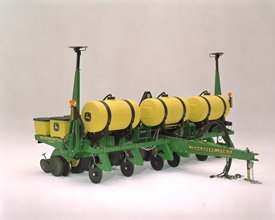 1755 6-row with three 70-gallon tanks
1755 6-row with three 70-gallon tanks
70 U.S. gallon tanks for 1755 and 1785 Rigid Planters.
These tanks can be ordered by themselves and used for water ballast to improve planter opener penetration. For use with fertilizer application, order complete fertilizer bundles.
When filled with water, each 70-gallon tank adds approximately 650 lb of weight to planter. Tanks are required when penetration is limited by machine weight; for example, when frame-mounted coulters with adjustable down-force springs are used together and fertilizer attachments are not used.
NOTE: Not recommended for 1765 or 1775 12Row30 Planters.
IMPORTANT: Warning and tail lamps recommended for planter since fertilizer attachment could obscure tractor tail and/or warning lamps.
Miscellaneous
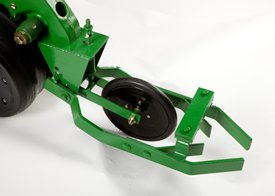 Drag closing system
Drag closing system
Designed to improve seed emergence in particularly difficult soil conditions that severely bake and crust after planting. These conditions are found primarily in irrigated cotton planting areas of the southwestern United States.
A seed packer wheel precedes the drag and pushes seed down into the moist soil. Drag brings loose soil into seed furrow without compaction. Without the typical closing compaction, the covering soil acts like a mulch, reducing the tendency to crust for improved seed emergence.
Only for use in fields that are relatively level and free of residue and clods that could cause plugging.
NOTE: Not compatible with leveling chains, tine tooth incorporators, rear-mounted granular insecticide or herbicide attachments, seed packer wheel or insecticide diffusers.
Rubber tire closing system
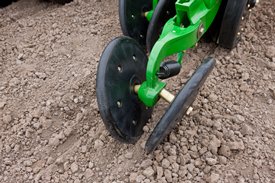 Rubber tire closing system
Rubber tire closing system

Rubber tire wheels are recommended for most conventional, minimum-till, and no-till planting conditions. Multiple levels of spring force are available, and are easily set with the integrated T-handle adjustment.
Cast iron closing wheels
 Cast-closing wheels
Cast-closing wheels

Cast-iron wheels are recommended for use in tough soil conditions where additional closing force is required.
Disk closing system
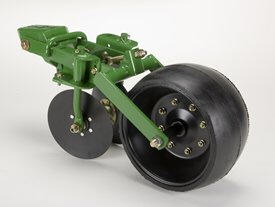 Disk closing system
Disk closing system

The disk closing system is recommended for very shallow planting depths. Two small disks are used to gently firm soil around the seed. These disks are followed by a wide packer wheel to gently pack the soil surface. This system is not recommended for use in high residue applications.
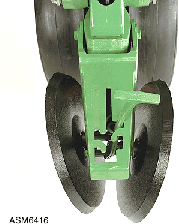 Cast-iron closing wheel system
Cast-iron closing wheel system
To convert planters equipped with rubber-tire closing wheels to cast-iron closing wheels.
May be used where rubber-tire closing wheels do not adequately close seed trench.
For individual cast wheels only, order AA34350 from Service Parts.
- NOTE: Cast-iron closing wheels are not recommended in conventional tilled ground.
 Rubber-tire closing wheel
Rubber-tire closing wheel
Converts planters equipped with cast-iron closing wheels to rubber-tire closing wheels.
Used in all types of planting conditions.
For individual rubber-tire closing wheels only, order AA39968 from Service Parts.
Limited by their ability to close seed trench in extreme soil conditions.
NOTE: For wheels only, order AA39968 from Parts.
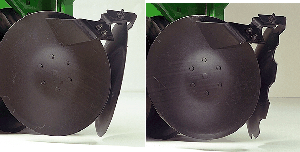 Furrowers with solid or notched leading blade
Furrowers with solid or notched leading blade
Used in tilled soil to move dry soil away from the planting unit path to plant in moist soil.
NOTE: Cannot be used on row spacing of less than 30 in.
Furrowers are used in conservation tillage conditions to sweep trash and a small volume of soil to the sides to clear a path for the planting unit.
Furrowers have alternating right and left-hand leading blade to assure straight planter draft.
Effectiveness of furrowers is limited by the trash-cutting ability of the attachment.
Available with two 13-in. solid blades or with a notched blade in the leading position. Leading notched blade provides improved cutting action.
The blade mounting bracket is adjustable to change the contact angle for improved sweeping action.
Depth is easily adjustable. Convenient pointer and scale give easy-to-read reference point.
Furrowers are not compatible with unit or frame-mounted coulters.
Drive chain shields are required when using conservation disk furrower with planters that have drive/gauge wheels mounted to the rear. (Not required on 1760, 1770 12Row30 or 1780 Planters.)
Finger pickup meter
 Finger pickup meter
Finger pickup meter
Finger pickup meters continue to be a reliable metering system for corn by providing consistent seed spacing and population control in mixed seed varieties. Recent changes to the finger, including shortening and adjusting the angle of the flag on the finger, have further increased the accuracy of our finger pickup seed meter.
- The finger pickup meter provides consistent seed spacing and population control when planting corn. It also has good performance in metering confectionery (large) sunflower seeds. The meter handles all normal sizes of U.S. seed corn (except popcorn) and larger sizes of No. 2 sunflower seed. For smaller sizes of No. 2 and all No. 3 and No. 4 sunflower seeds, order sunflower finger assembly from (Parts).
NOTE: The size of No. 2 sunflower seed varies considerably among suppliers. When planting the larger size of No. 2 sunflower seeds, as well as the No. 1 seed, BA30041 corn finger pickup meter is recommended. A37177 finger is available to improve performance of finger pickup meter for No. 2 and smaller seed. Finger can be installed in existing holder or a new finger-and-holder assembly (AA31262) can be ordered through Parts.
Feed cup meter
 Feed cup meter
Feed cup meter
The feed cup is an economical meter designed for volumetric seed metering. Seeds are not singulated in this style of metering system. Therefore, this type of volumetric meter will not provide the most accurate seed spacing.
Feed cup meter planting accuracy will be influenced by seedbed conditions and the operating characteristics of the seed meter. Rough seedbeds and fast planting speeds typically deteriorate seed placement accuracy.
Feed cups are available for soybeans, edible beans, acid-delinted cotton, and regular or low-rate sorghum.
Upforce / Downforce spring systems
Planter row-unit downforce is an important factor to ensure consistent and proper depth control. Downforce systems are used to keep the planting units from bouncing on rough seedbeds and to improve planter penetration in heavy residue and harder soil conditions. The amount of downforce required is determined by how the planter is equipped and the field conditions in which the planter is used.
Non-adjustable springs can also be used to apply upforce on the row-units. Upforce can be achieved by changing the orientation of the spring on the parallel arms. This upforce can be used to counteract excess
row-unit margin or extra weight cause by seed, tillage, or other attachments on the row-unit. Upforce springs will limit the maximum amount of downforce that can be place on a row-unit by the downforce system and should only be used in conditions were adequate and consistent depth control is easily maintained.
Non-adjustable springs in the upforce or downforce position can also be used to counteract variances in row to row. When used in conjunction with the pneumatic downforce system, non-adjustable springs can be used to provide a more consistent row-unit margin on each row by compensating for inconsistencies such as tire tracks, different row-unit tillage attachments, and other various attachments.
Non-adjustable springs
 Non-adjustable springs, row-unit upforce
Non-adjustable springs, row-unit upforce
A single set of springs apply approximately 90 lb of upforce / downforce per row. Two sets of springs can be used for 180 lb of force per row.
Non-adjustable downforce springs are recommended for use in conventional tilled soil for planting speeds over 5 mph and/or in rough-tilled seedbed conditions. Non-adjustable springs can be used with tillage attachments in lighter, conventional tilled soils. (Not recommended for use with unit- or frame-mounted coulter.)
 Dual upforce springs 1700 TR
Dual upforce springs 1700 TR
Adjustable heavy-duty springs
 Adjustable, heavy-duty downforce springs
Adjustable, heavy-duty downforce springs
Adjustable, heavy-duty downforce can be used to apply 0 lb to 400 lb of downforce per row and has four settings: 0 lb, 125 lb, 250 lb, and 400 lb. The adjustable, heavy-duty downforce system can be used in all planting conditions and is compatible with all tillage attachments (recommended with unit-mounted coulter, row cleaners, and unit-mounted double-disk fertilizer openers in conservation planting conditions).
- NOTE: Compatible with all MaxEmerge™ Plus planters. Vacuum planters built prior to June 1992 require updated manifold brackets (A52970) to eliminate adjustment interference.
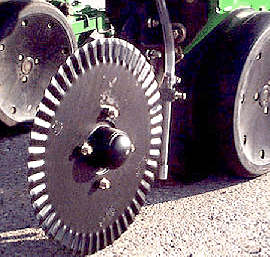 Unit-mounted liquid fertilizer injection opener
Unit-mounted liquid fertilizer injection opener
The single-disk, unit-mounted injection opener is available for many of the integral planter models along with some of the drawn planter models. It is capable of working in all soil conditions. However, it is best suited for no-till conditions in which the double-disk opener has limited residue cutting and penetration capabilities.
This system incorporates a 16-in. 50-flute blade for good cutting and penetration capabilities. The coulter blade runs 2 in. off the seed furrow.
This is an injection fertilizer opener system. The coulter blade opens the soil; a 1/2-in. tube and nozzle assembly injects the fertilizer into the trench. Application rates are 2.4 U.S. gal per acre to 37.6 U.S. gal per acre.
This single-disk opener is not compatible with any other row tillage or row-unit-mounted attachment.
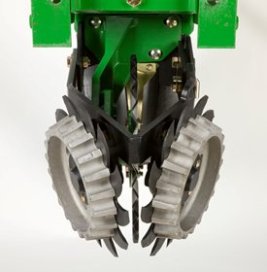 Floating row cleaner
Floating row cleaner
 Floating row cleaner side view
Floating row cleaner side view
When paired with a unit-mounted coulter, the floating combo row cleaner offers the ultimate solution for managing tough residue and soil conditions. The row cleaner clears the way of debris, and the coulter penetrates tough soil, opening the furrow for the row unit opener blades. The floating ability of the row cleaner allows the unit to adapt to varying terrain independently of the row unit.
Features
The floating row cleaner allows a row cleaner to be used in conjunction with a unit-mounted coulter.This combination is often desired in heavy residue loads and tough reduced tillage planting conditions. The floating row cleaner features the SharkTooth® wheel. The beveled, sharpened edge of the teeth on the SharkTooth aggressively cuts flat and standing residue in the path of the row unit. The curved tooth design sweeps a clear path for the unit mounted coulter and opener blades, and resists residue buildup.
When used with the unit mounted coulter, the wheels are run side-by-side. They may be operated with one wheel forward if desired, by simply relocating the wheels to existing holes on the row cleaner bracket. The wheel bearings of the floating row cleaner are sealed and require no regular maintenance.
Cast aluminum depth gauge bands are standard equipment on the floating row cleaner. These durable bands are mounted directly to the row cleaner wheel, and aid the row cleaner in maintaining a consistent operating depth over varying terrain. The depth gauge bands also add weight to the row cleaner, aiding penetration in tough conditions. The depth gauge bands may be removed if desired.
Adjustability
The floating row cleaner is designed with maximum terrain following flexibility in mind. The pin adjustment has multiple settings available in 1/4-in. increments. The primary method of operating is to limit the maximum depth of operation, and allow the row cleaner to float up when necessary. This is accomplished by placing the adjustment pin below the floating bracket, limiting downward travel, but permitting upward travel.
It is also possible to set the row unit in a manner allowing full float. Simply place the pin in the lowest setting, allowing the depth gauge bands to determine the operating depth up and down. In some conditions, it may be desirable to pin the unit in a fixed position. This may be accomplished by simply pinning through the floating arm, fixing the row cleaner arm to the row unit and allowing the row unit to control operating depth.
Operational notes
SharkTooth® is a U.S.-registered trademark of Yetter Manufacturing.
NOTES:
-
Not compatible with any row spacing less than 30 inches, except the 1790 Split-Row Planter.
-
Not compatible with Deere/Bauer or Deere/Orthman planters.
-
Drive wheel chain shields are recommended for use with row cleaner attachments.
-
Long parallel arms are required for use on:
-
1750
-
1760NT
-
1770NT when used in conjunction with frame mounted fertilizer openers
-
1790 front rank when used with frame mounted fertilizer openers
-
1790 rear rank
-
-
For available long parallel arm attachments for field conversion, please click here.
-
Use of long parallel arms is recommended, but not required, when using the floating row cleaner on 1770 Flex Planters in conjunction with frame-mounted fertilizer openers. Use of long parallel arms on these machines will maximize the distance between the fertilizer openers and the row cleaner, preventing interference and maximizing residue flow.
-
Other row cleaner designs are available for use without a unit mounted coulter, or for use with unit-mounted double disk fertilizer openers.
-
Use of row cleaners and unit-mounted coulters is not recommended when surface application pre-plant herbicide is used prior to planting. when using pre-plant incorporated herbicide, the row cleaner should be adjusted to minimize soil disturbance so as not to reduce the effectiveness of the incorporated herbicide.
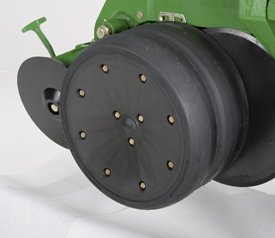 Dual gauge wheels installed
Dual gauge wheels installed
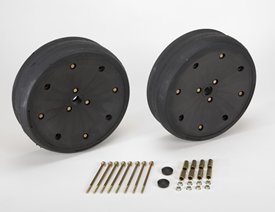 Dual gauge wheel components
Dual gauge wheel components
For 1700, 1710, 1720, 1730, 1750, and 1760 Planters and individual planting units ordered for the same planters. Provide additional flotation in light, well prepared seedbeds. Especially desirable when planting on beds. Recommended only for smooth, tilled soil.
NOTES:
- Not compatible with less than 36-in. row spacings
- Not compatible with conservation furrowers
- Not compatible with V-wing bed sweep unless the sweeps are mounted in forward parallel arm holes (requires two 28H860 washers from parts).
- Not compatible with walking gauge wheels.
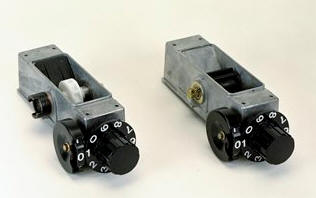 Herbicide and insecticide meters
Herbicide and insecticide meters
Permits addition of herbicide to the planting unit already equipped with insecticide for dual insecticide/herbicide applications.
Includes herbicide meter, chemical hopper divider, and rear spreader.
Does not include chemical hopper.
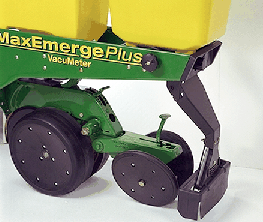 Rear band spreader shown with windshield
Rear band spreader shown with windshield
Includes granular insecticide (with components for seed furrow placement and front or rear band spreader capability) plus herbicide with rear-mounted spreader.
Insecticide can be placed ahead of closing wheels (in-furrow or banded) or behind closing wheels (banded). Hopper, hopper divider, drive, and meters are included.
Windshield is available to decrease wind effect on distribution pattern (order separately).
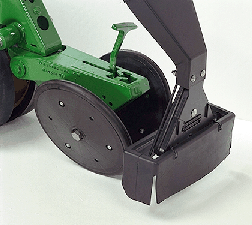 Rear-mount spreader
Rear-mount spreader
In order to add dry chemical (herbicide) capability to planters equipped with MaxEmerge™ row units, the installation of the dry chemical hopper, meter, drive chains, rear-mounted spreader, and related attachment hardware are needed.
As seen fully assembled in the picture to the left, the herbicide spreader is equipped with a series of baffles that distribute the dry granules on the ground in a band approximately 14 in. wide. Along with the spreader assembly, a windshield is available to decrease the effect wind has on distribution pattern (order BA25340 separately).
- NOTE: Not compatible with the seed packer wheel attachment or disk closing system.
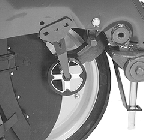 Seed furrow placement
Seed furrow placement
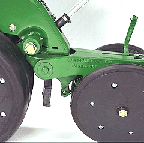 Band spreader placement
Band spreader placement
Includes hopper, meter and both seed furrow placement and front band spreader components.
Granular chemical meters have a meter wheel for applications of up to 8 oz. per 1000 ft of row. For higher application rates, order the fluted roller for the meter (A50863) from Parts.
When seed furrow placement is used, insecticide is placed in seed furrow with the seed ahead of closing
wheel.
When band spreader is used, insecticide is placed on ground in a band approximately 7-in. wide ahead or behind closing wheels.
Available with regular or closed-chemical hopper lids.
- NOTES:
- 1. Using rear-mount bracket (Code 9450/BA24528) allows using band spreader behind closing wheels.
- 2. Not compatible with seed packer wheel attachment or disk closing system.
- 3. Not compatible with 3.0 bushel seed hoppers.
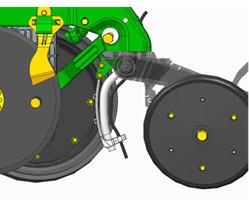 Hose guide is a flexible material and is black in production but shown in white in these pictures.
Hose guide is a flexible material and is black in production but shown in white in these pictures.
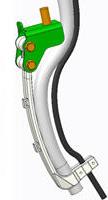
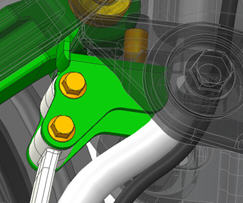
The in-furrow liquid fertilizer and dry insecticide row-unit attachment kit will be offered as an AFC only. It is compatible with MaxEmerge™ 5 row-units, ExactEmerge™ row-units and older XP row-units with in-furrow fertilizer or with granular insecticide or with both. This attachment is designed to work with the 8-mm liquid in-furrow fertilizer hose and 1.9-cm (3/4-in.) dry insecticide hose. It can be configured in three different ways.
- To apply both liquid fertilizer and dry insecticide in the trench at the same time
- To apply liquid fertilizer only
- To apply dry insecticide only in the trench (not compatible with banding option)
This BA32912 kit is able to be installed to the closing system with the existing hardware using one bolt. This allows for a quick install and the tab on the front of the bracket keeps the orientation. No need to remove the gauge wheels or opener blades. The hose or hoses can be routed through the hole in the shank casting and closing wheel.
The BA32912 kit includes the following hardware and brackets
- A102159 x1 – guide
- A102158 x1 – bracket
- 14M7397 x2 – locknut
- 14M7746 x2 – locknut
- 19M8092 x2 – screw
- 19M9752 x2 – screw
- A103650 – electronic document
Other items needed based on number of kits order. Most dealerships already have these supplies stocked.
- One zip-tie/tie strap per row (recommended a 3 mm or 1/8 in. width)
- R96703 is a recommendation and quantity of one per package
- 0.9 m (3 ft) of 8-mm (0.31-in.) hose per row
- A94657 is 200 m (656 ft) of hoses and would complete approximately 218 rows.
 Rear-mount spreader
Rear-mount spreader
In order to add dry chemical (herbicide) capability to planters equipped with MaxEmerge™ row units, the installation of the dry chemical hopper, meter, drive chains, rear-mounted spreader, and related attachment hardware are needed.
As seen fully assembled in the picture to the left, the herbicide spreader is equipped with a series of baffles that distribute the dry granules on the ground in a band approximately 14 in. wide. Along with the spreader assembly, a windshield is available to decrease the effect wind has on distribution pattern (order BA25340 separately).
- NOTE: Not compatible with the seed packer wheel attachment or disk closing system.
 Seed furrow placement
Seed furrow placement
 Band spreader placement
Band spreader placement
Includes hopper, meter and both seed furrow placement and front band spreader components.
Granular chemical meters have a meter wheel for applications of up to 8 oz. per 1000 ft of row. For higher application rates, order the fluted roller for the meter (A50863) from Parts.
When seed furrow placement is used, insecticide is placed in seed furrow with the seed ahead of closing
wheel.
When band spreader is used, insecticide is placed on ground in a band approximately 7-in. wide ahead or behind closing wheels.
Available with regular or closed-chemical hopper lids.
- NOTES:
- 1. Using rear-mount bracket (Code 9450/BA24528) allows using band spreader behind closing wheels.
- 2. Not compatible with seed packer wheel attachment or disk closing system.
- 3. Not compatible with 3.0 bushel seed hoppers.
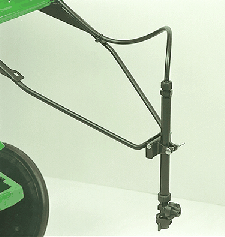 Liquid herbicide pre-emerge spray attachment
Liquid herbicide pre-emerge spray attachment
Applies pre-emerge liquid herbicide behind planting units.
Lower parts of attachment pivot rearward to prevent damage from obstructions such as corn stalks. Easy vertical adjustment permits quick setting of spray band width. Adapters are included to allow using flood tip nozzles for extended coverage. Approximate spray widths are:
- ''Even'' type spray tips are recommended for spraying in bands from 7 to 17 in. with the nozzle in the lower position (shown).
- The support tube may be inverted, placing the nozzle in the ''up'' position. Coverage in this position is from 50 to 90 in. in width when using flood type spray tips. This type of coverage is not recommended for less than 1/2 gallon per minute flow.
Check valves, nozzle bodies, and quick-attach nozzle caps are included for changing tips fast and easy without the use of tools. Also, this attachment for field conversion includes the distribution manifolds and hoses.
This attachment for field conversion does not include nozzle tips and strainers; see SprayMaster™ sprayer parts and accessories. Also, this attachment for field conversion does not include but requires (customer-supplied) tractor-mounted controls, tanks, pump and filters.
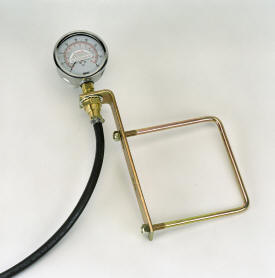 Pressure gauge for liquid fertilizer system
Pressure gauge for liquid fertilizer system
The pressure gauge allows monitoring of the liquid pressure in the fertilizer high-pressure manifold. Pressure gauge is compatible with all piston pump applications, both current and noncurrent. By being able to monitor the pressure, the operator will know when there is a plugged orifice or strainer in the system.
NOTE: Not for planters with SeedStarTM monitoring systems.
The following are some operational tips for better performance when using the pressure gauge:
- Working pressure should be from 20 psi to 70 psi in the high-pressure manifold.
- If pressure exceeds 70 psi, inspect and clean the 50-mesh strainer and orifice in the manifold. If the strainer and orifice are not plugged, replace the orifice with the next-larger-sized orifice.
- Use the largest orifice possible to operate within the 20-psi to 70-psi pressure range. Two orifices, #43 and #59, are provided with the piston pump. Four other orifices, #31, #47, #78, and #95, are available through Parts.
- Proper filtering of the liquid fertilizer is important to prevent obstruction of the orifices and damage to the system. Clean and inspect the 80-mesh strainer in the line at the bottom of the pump. Other strainers, 50-mesh and 24-mesh, are available through Parts.
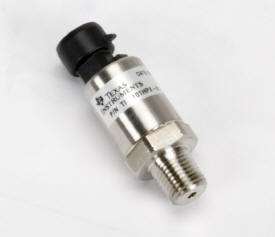 Fertilizer pressure sensor for SeedStar
Fertilizer pressure sensor for SeedStar
To adapt 1730 and 1780 Rigid Planters liquid herbicide attachment for 15- through 20-in. row spacing applications. Contains manifold for up to eight rows and hose connector to pump.
Does not include manifold distribution parts for 1/4-in. hose and spray nozzles. Does not include any hose pump or control. Order hose through Parts.
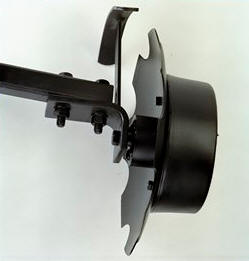 Outer marker arm and disk
Outer marker arm and disk
Enables converting from one type of marker arm extension and marker disk blade to another. For all marker designs except as noted.
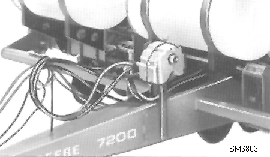 PTO-driven hydraulic vacuum pump
PTO-driven hydraulic vacuum pump
A PTO-driven hydraulic pump allows operators to use the vacuum seed meter system with open-center hydraulic tractors and/or a 540 rpm or 1000 rpm PTO. The 540 rpm PTO system is compatible with 4Row through 9Row planters and provides 3.9 gpm at 80 percent of rated speed. The 1000 rpm PTO system is compatible with 4Row through 15Row planters and provides 5.0 gpm at 80 percent of rated speed. Both the 540 and 1000 rpm PTO pumps are for single vacuum motors only and inadequate for dual vacuum motors systems.
Flat seed disks such as edible bean and sweet corn require higher levels of vacuum. These disks require a dual vacuum motor configuration on planters over 8 rows. Neither the 540 or 1000 rpm PTO pump is adequate for flat seed disk operation.
9000 Codes include an oil cooler, except with 4-row planters with 540 rpm pump. When ordering PTO pump as a bundle, you must also order the oil cooler bundle, except with the 540 rpm PTO pump for 4-row applications.
 Pneumatic downforce assembly
Pneumatic downforce assembly
Improved pneumatic downforce systems are available as a factory-installed option on all planters and as a field conversion bundle for all MaxEmerge™ 5, MaxEmerge XP, MaxEmerge Plus, and MaxEmerge 2 planters. All pneumatic downforce field conversion bundles contain upgraded components to reflect pneumatic system upgrades for model year 2011.
Row-unit downforce is infinitely variable from 0 lb to 400 lb. (0 kg to 181.4 kg). A gauge and/or display provides a reading as to how much downforce the system is providing. The downforce is constant at all times during operation.
On all model year 2011 and newer 1775NT, 1775NT CCS™, 1795, and DB Series Planters, the pneumatic downforce adjustment is displayed within the GreenStar™ 2 Display as base equipment. However, when converting a model year 2010 and older 1770NT, 1770NT CCS, 1790, and DB Series Planter, the air compressor assembly and gauge need to be mounted within the tractor cab, similar to factory-installed pneumatic downforce equipment configurations for that model year.
Each row-unit has a single air bag located between the parallel arms. The air bag is hooked in parallel so air can be added or released from all rows at once from one location. Split-row planters have the corn row-units and soybean rows plumbed separately, so the pressure can be removed from the bean rows when planting corn.
MaxEmerge 2 row-units with long parallel arms must have the arms changed to current production parallel arms. This ensures the correct hole pattern for pneumatic downforce. Refer to the attachment description to order the appropriate bundle for the frame size.
NOTE: Row-units with long parallel arms require A54544 spacer block if not so equipped (Service Parts).
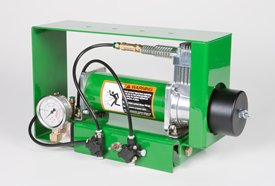 In-cab compressor assembly
In-cab compressor assembly
An air compressor, located either in the tractor cab or on the frame, pumps up the system. Integral planter models ordered with pneumatic downforce from the factory have in-cab mounting as base equipment. For drawn planter models, the air compressor assembly is mounted onto the planter frame for model year 2011. Prior to model year 2011, the 1775NT, 1775NT CCS™, 1795, and DB Series Planters have the air compressor mounted within the tractor cab from the factory.
Valves located on the compressor allow bleed-off of the system. Interplant rows are shut off entirely when those rows are locked up.
Field conversion bundles have been established for upgrading pneumatic downforce systems. With the bundle structure, order the individual components for a pneumatic downforce system. There are individual bundles for the air compressor, the row-unit downforce assembly, and a hose kit.
Each planter requires one air-compressor bundle, a number of row-unit downforce assemblies equal to the number of rows on the planter, and a hose kit for each 12 rows being equipped with pneumatic downforce. There are four different row-unit downforce assembly attachments. The selection of the row-unit downforce assemblies is based on the type of meter drive, chain or Pro-Shaft™, and type of parallel arms being utilized, regular or long, on the row-units.
 Pneumatic downforce assembly
Pneumatic downforce assembly
Improved pneumatic downforce systems are available as a factory-installed option on all planters and as a field conversion bundle for all MaxEmerge™ 5, MaxEmerge XP, MaxEmerge Plus, and MaxEmerge 2 planters. All pneumatic downforce field conversion bundles contain upgraded components to reflect pneumatic system upgrades for model year 2011.
Row-unit downforce is infinitely variable from 0 lb to 400 lb. (0 kg to 181.4 kg). A gauge and/or display provides a reading as to how much downforce the system is providing. The downforce is constant at all times during operation.
On all model year 2011 and newer 1775NT, 1775NT CCS™, 1795, and DB Series Planters, the pneumatic downforce adjustment is displayed within the GreenStar™ 2 Display as base equipment. However, when converting a model year 2010 and older 1770NT, 1770NT CCS, 1790, and DB Series Planter, the air compressor assembly and gauge need to be mounted within the tractor cab, similar to factory-installed pneumatic downforce equipment configurations for that model year.
Each row-unit has a single air bag located between the parallel arms. The air bag is hooked in parallel so air can be added or released from all rows at once from one location. Split-row planters have the corn row-units and soybean rows plumbed separately, so the pressure can be removed from the bean rows when planting corn.
MaxEmerge 2 row-units with long parallel arms must have the arms changed to current production parallel arms. This ensures the correct hole pattern for pneumatic downforce. Refer to the attachment description to order the appropriate bundle for the frame size.
NOTE: Row-units with long parallel arms require A54544 spacer block if not so equipped (Service Parts).
 In-cab compressor assembly
In-cab compressor assembly
An air compressor, located either in the tractor cab or on the frame, pumps up the system. Integral planter models ordered with pneumatic downforce from the factory have in-cab mounting as base equipment. For drawn planter models, the air compressor assembly is mounted onto the planter frame for model year 2011. Prior to model year 2011, the 1775NT, 1775NT CCS™, 1795, and DB Series Planters have the air compressor mounted within the tractor cab from the factory.
Valves located on the compressor allow bleed-off of the system. Interplant rows are shut off entirely when those rows are locked up.
Field conversion bundles have been established for upgrading pneumatic downforce systems. With the bundle structure, order the individual components for a pneumatic downforce system. There are individual bundles for the air compressor, the row-unit downforce assembly, and a hose kit.
Each planter requires one air-compressor bundle, a number of row-unit downforce assemblies equal to the number of rows on the planter, and a hose kit for each 12 rows being equipped with pneumatic downforce. There are four different row-unit downforce assembly attachments. The selection of the row-unit downforce assemblies is based on the type of meter drive, chain or Pro-Shaft™, and type of parallel arms being utilized, regular or long, on the row-units.
 Pneumatic downforce assembly
Pneumatic downforce assembly
Improved pneumatic downforce systems are available as a factory-installed option on all planters and as a field conversion bundle for all MaxEmerge™ 5, MaxEmerge XP, MaxEmerge Plus, and MaxEmerge 2 planters. All pneumatic downforce field conversion bundles contain upgraded components to reflect pneumatic system upgrades for model year 2011.
Row-unit downforce is infinitely variable from 0 lb to 400 lb. (0 kg to 181.4 kg). A gauge and/or display provides a reading as to how much downforce the system is providing. The downforce is constant at all times during operation.
On all model year 2011 and newer 1775NT, 1775NT CCS™, 1795, and DB Series Planters, the pneumatic downforce adjustment is displayed within the GreenStar™ 2 Display as base equipment. However, when converting a model year 2010 and older 1770NT, 1770NT CCS, 1790, and DB Series Planter, the air compressor assembly and gauge need to be mounted within the tractor cab, similar to factory-installed pneumatic downforce equipment configurations for that model year.
Each row-unit has a single air bag located between the parallel arms. The air bag is hooked in parallel so air can be added or released from all rows at once from one location. Split-row planters have the corn row-units and soybean rows plumbed separately, so the pressure can be removed from the bean rows when planting corn.
MaxEmerge 2 row-units with long parallel arms must have the arms changed to current production parallel arms. This ensures the correct hole pattern for pneumatic downforce. Refer to the attachment description to order the appropriate bundle for the frame size.
NOTE: Row-units with long parallel arms require A54544 spacer block if not so equipped (Service Parts).
 In-cab compressor assembly
In-cab compressor assembly
An air compressor, located either in the tractor cab or on the frame, pumps up the system. Integral planter models ordered with pneumatic downforce from the factory have in-cab mounting as base equipment. For drawn planter models, the air compressor assembly is mounted onto the planter frame for model year 2011. Prior to model year 2011, the 1775NT, 1775NT CCS™, 1795, and DB Series Planters have the air compressor mounted within the tractor cab from the factory.
Valves located on the compressor allow bleed-off of the system. Interplant rows are shut off entirely when those rows are locked up.
Field conversion bundles have been established for upgrading pneumatic downforce systems. With the bundle structure, order the individual components for a pneumatic downforce system. There are individual bundles for the air compressor, the row-unit downforce assembly, and a hose kit.
Each planter requires one air-compressor bundle, a number of row-unit downforce assemblies equal to the number of rows on the planter, and a hose kit for each 12 rows being equipped with pneumatic downforce. There are four different row-unit downforce assembly attachments. The selection of the row-unit downforce assemblies is based on the type of meter drive, chain or Pro-Shaft™, and type of parallel arms being utilized, regular or long, on the row-units.
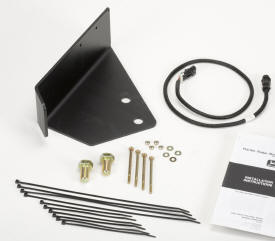 Mounting bracket and adapter harness
Mounting bracket and adapter harness
The planter radar is for SeedStarTM and ComputerTrakTM systems. The SeedStar and ComputerTrak 250, 350, and 450 monitor systems require radar.
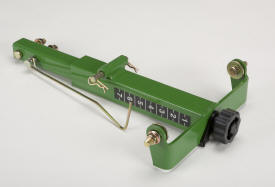 Row tillage support bracket
Row tillage support bracket
Includes pointer, scale, and large easy-to-use adjustment knob for convenient adjustment to desired working depth.
Required with tine tooth tillage, conservation furrower, and V-wing attachments when ordered as extra equipment.
NOTES:
1) Not compatible with unit- or frame-mounted coulters or heavy-duty parallel arms.
2) For MaxEmerge™ 2 planters built prior to June 1991, order A52092 cast lower parallel arm.
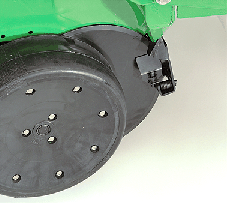 Heavy-duty scrapers
Heavy-duty scrapers
Recommended for extremely sticky soils where even rotary scrapers have problems keeping Tru-VeeTM disks clean.
Scraper blades are heat treated for added wear.
- NOTE: Not compatible with any row-unit tillage attachments except conservation furrowers, unit-mounted coulter, and unit-mounted row cleaner.
 Screw-adjust, unit-mounted row cleaner
Screw-adjust, unit-mounted row cleaner
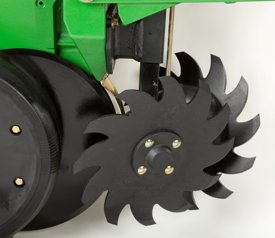 SharkTooth® wheel
SharkTooth® wheel
The screw-adjust, unit-mounted row cleaner is mounted directly to the face plate of the row unit, placing the ground-engaging components just in front of the row unit opener blades and depth gauge wheels. This close proximity allows the gauge wheels to control the depth of the row cleaner as well as the row unit. This compact design also allows greater compatibility with fertilizer openers and other planter attachments.
Features
The unit-mounted row cleaner features the SharkTooth® wheel. The beveled, sharpened edge of the teeth on the SharkTooth aggressively cut tough residue that lies in the path of the row unit. The curved-tooth design sweeps a clear path for the openers and resists residue buildup. The wheels are arranged in a staggered fashion with one wheel leading the other, ensuring complete clearing of the row unit path. The bearing on the SharkTooth wheel is sealed and requires no regular maintenance. Bearing shields are used between the wheel and the mount bracket to prevent residue wrapping and buildup around the bearing housing.
Adjustability
The unit-mounted row cleaner offers a convenient screw adjustment feature for changing the depth setting. The Acme screw is enclosed within the structure of the mounting bracket, providing protection from the elements. The adjustment knob for the screw adjustment is accessible from the top of the parallel arms. The knob can be adjusted by hand, or by using a socket. The adjustment is detented in 1/16-in. increments, allowing for quick, easily repeatable adjustments across all rows of the planter. An indicator rod and scale on the front of the row cleaner bracket indicate the current setting. If a condition is encountered where use of the row cleaner is not desired, it can be set so that the wheels do not engage the soil surface.
Operational notes and compatibility
Use of row cleaners is not recommended when surface application pre-plant herbicide is used prior to planting. When using pre-plant incorporated herbicide, the row cleaner should be adjusted to minimize soil disturbance so as not to reduce the effectiveness of the incorporated herbicide.
Drive chain shields are recommended for use with row cleaner attachments.
NOTES:
-
Not compatible with use of frame-mounted coulter.
-
Not compatible with any row spacing less than 30 in.
-
For 1790 12/23, 12/24, 16/31, and 16/32 row machines, unit-mounted row cleaners recommended provided on the front rank of row units only.
-
For DB60 47R15 machines, unit-mounted row cleaners are recommended on the 24 row units with short parallel arms only.
-
Other row cleaner designs are available for compatibility with unit-mounted coulters and row unit-mounted double-disk fertilizer openers.
- Bundle is not compatible with long parallel arms. If purchasing for use on a long parallel arm machine, a separate bracket must be ordered from Service Parts.
- Drive wheel chain shields are not required on 1760, 1770 12Row30 (non-NT), or 1780 Front-Fold Planters.
- Drive wheel chain shields are required on other compatible models. Order BA25697 for the 1750 Standard Planter. Order BA24093 for all planters except the 1750 Standard.
SharkTooth® is a U.S.-registered trademark of Yetter Manufacturing.
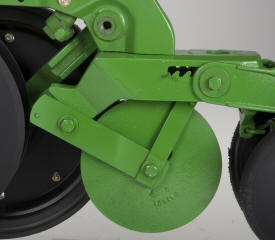 Seed packer wheel
Seed packer wheel
For use when planting cotton in special growing conditions found primarily in southwestern United States.
Some particularly difficult soil types found in these areas are susceptible to severe ''baking and crusting'' if sufficient wind, soil moisture, temperature and sunlight conditions are present. In these situations, it is important to achieve adequate seed/soil contact while minimizing soil surface compaction.
Includes a wheel that runs ahead of the closing wheels to press the cotton seed into the bottom of the furrow.
Using the packer wheel enables the regular closing wheels to be used with a minimum force setting.
Wheels should not be used in the following conditions:
- Moist soil conditions.
- Contour planting application.
- Reduced tillage conditions (typical corn-belt conditions).
Not compatible with:
- Front band insecticide spreader.
- Rear-mounted herbicide/insecticide attachments.
- Disk closing.
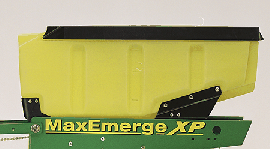 Plastic 3.0 bushel hopper and lid
Plastic 3.0 bushel hopper and lid
Attachments for field conversion are available for complete seed hoppers and lids. Includes plateless and vacuum plastic 1.6 or 3.0 bushel seed hopper and lid. Seed meter, drive, and latch must be ordered separately if needed. These are for MaxEmerge™ XP rows only.
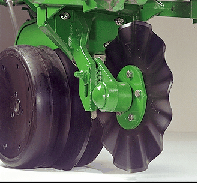 Unit-mounted coulter (shown with fluted blade)
Unit-mounted coulter (shown with fluted blade)
Adapts planter to plant in reduced tillage conditions.
Nodular iron coulter arm mounts directly to planting unit shank to utilize full unit weight for penetration.
Unit gauge wheels provide depth control.
Coulter blade is positioned directly ahead of Tru-Vee™ opener to ensure accurate tillage in seed zone.
Rippled or fluted blades are available to suit a wide range of tillage and soil conditions.
NOTES:
1) Not compatible with tine tooth tillage, furrower attachments, V-wing bed sweep frame-mounted coulter or unit-mounted row cleaner.
2) Ballast attachment (or fertilizer attachment) may be required for penetration.
3) BA28970 or BA28971, heavy-duty adjustable downforce springs or pneumatic downforce system, are required to provide increased coulter penetration in hard soils and also to help keep unit from bouncing when being operated on rough seedbeds. (Not included with BA30078).
4) Requires A52092 cast heavy-duty lower regular parallel arm (one row) or A84382 heavy-duty lower long parallel arm (one row) from Service Parts. Heavy-duty long parallel arm is designed for use only with the unit-mounted coulter (not for tillage tool support bracket). Cast lower parallel arms have been standard equipment for a number of years, confirm what lower parallel arm subject planter is equipped with.
 Fertilizer pressure sensor for SeedStar
Fertilizer pressure sensor for SeedStar
 PTO-driven hydraulic vacuum pump
PTO-driven hydraulic vacuum pump
A PTO-driven hydraulic pump allows operators to use the vacuum seed meter system with open-center hydraulic tractors and/or a 540 rpm or 1000 rpm PTO. The 540 rpm PTO system is compatible with 4Row through 9Row planters and provides 3.9 gpm at 80 percent of rated speed. The 1000 rpm PTO system is compatible with 4Row through 15Row planters and provides 5.0 gpm at 80 percent of rated speed. Both the 540 and 1000 rpm PTO pumps are for single vacuum motors only and inadequate for dual vacuum motors systems.
Flat seed disks such as edible bean and sweet corn require higher levels of vacuum. These disks require a dual vacuum motor configuration on planters over 8 rows. Neither the 540 or 1000 rpm PTO pump is adequate for flat seed disk operation.
9000 Codes include an oil cooler, except with 4-row planters with 540 rpm pump. When ordering PTO pump as a bundle, you must also order the oil cooler bundle, except with the 540 rpm PTO pump for 4-row applications.
 PTO-driven hydraulic vacuum pump
PTO-driven hydraulic vacuum pump
A PTO-driven hydraulic pump allows operators to use the vacuum seed meter system with open-center hydraulic tractors and/or a 540 rpm or 1000 rpm PTO. The 540 rpm PTO system is compatible with 4Row through 9Row planters and provides 3.9 gpm at 80 percent of rated speed. The 1000 rpm PTO system is compatible with 4Row through 15Row planters and provides 5.0 gpm at 80 percent of rated speed. Both the 540 and 1000 rpm PTO pumps are for single vacuum motors only and inadequate for dual vacuum motors systems.
Flat seed disks such as edible bean and sweet corn require higher levels of vacuum. These disks require a dual vacuum motor configuration on planters over 8 rows. Neither the 540 or 1000 rpm PTO pump is adequate for flat seed disk operation.
9000 Codes include an oil cooler, except with 4-row planters with 540 rpm pump. When ordering PTO pump as a bundle, you must also order the oil cooler bundle, except with the 540 rpm PTO pump for 4-row applications.

